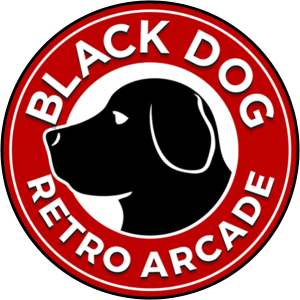



Released: 1993
Publisher: Midway / Acclaim Entertainment
Developer: Midway
Mortal Kombat II is a 1993 arcade fighting game originally produced by Midway for the arcades in 1993. It was later ported to multiple home systems, including MS-DOS, Amiga, Game Boy, Game Gear, Sega Genesis, 32X, Sega Saturn, Super Nintendo Entertainment System, and PlayStation only in Japan, mostly in licensed versions developed by Probe Entertainment and Sculptured Software and published by Acclaim Entertainment (currently distributed by Warner Bros. Interactive Entertainment).
It is the second main installment in the Mortal Kombat franchise and a sequel to 1992’s Mortal Kombat, improving the gameplay and expanding the mythos of the original Mortal Kombat, notably introducing more varied finishing moves (including several Fatalities per character and new finishers, such as Babality and Friendship) and several iconic characters, such as Kitana, Mileena, Kung Lao, Noob Saibot, and the series’ recurring villain, Shao Kahn. The game’s plot continues from the first game, featuring the next Mortal Kombat tournament set in the otherdimensional realm of Outworld, with the Outworld and Earthrealm representatives fighting each other on their way to challenge the evil emperor Shao Kahn.
You can read more about Mortal Kombat II here.
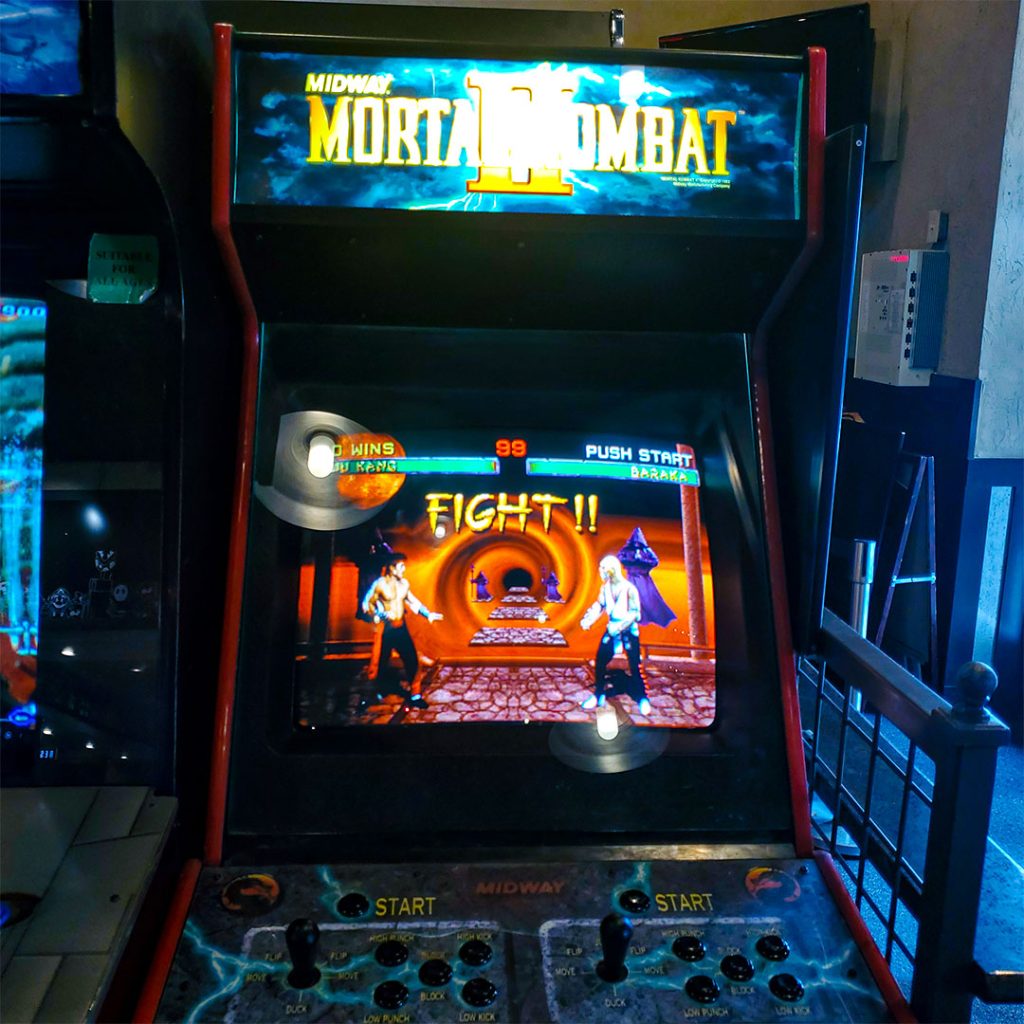
Released: 1981
Publisher: Sega/Gremlin
Developer: Konami
Frogger is a 1981 arcade action game developed by Konami and manufactured by Sega. In North America, it was released by Sega/Gremlin.
The objective of the game is to guide a frog to each of the empty homes at the top of the screen. The game starts with three, five, or seven frogs, depending on the machine’s settings. Losing all frogs is game over. The player uses the 4-direction joystick to hop the frog once. Frogger is either single-player or two players alternating.
You can read more about Frogger here.
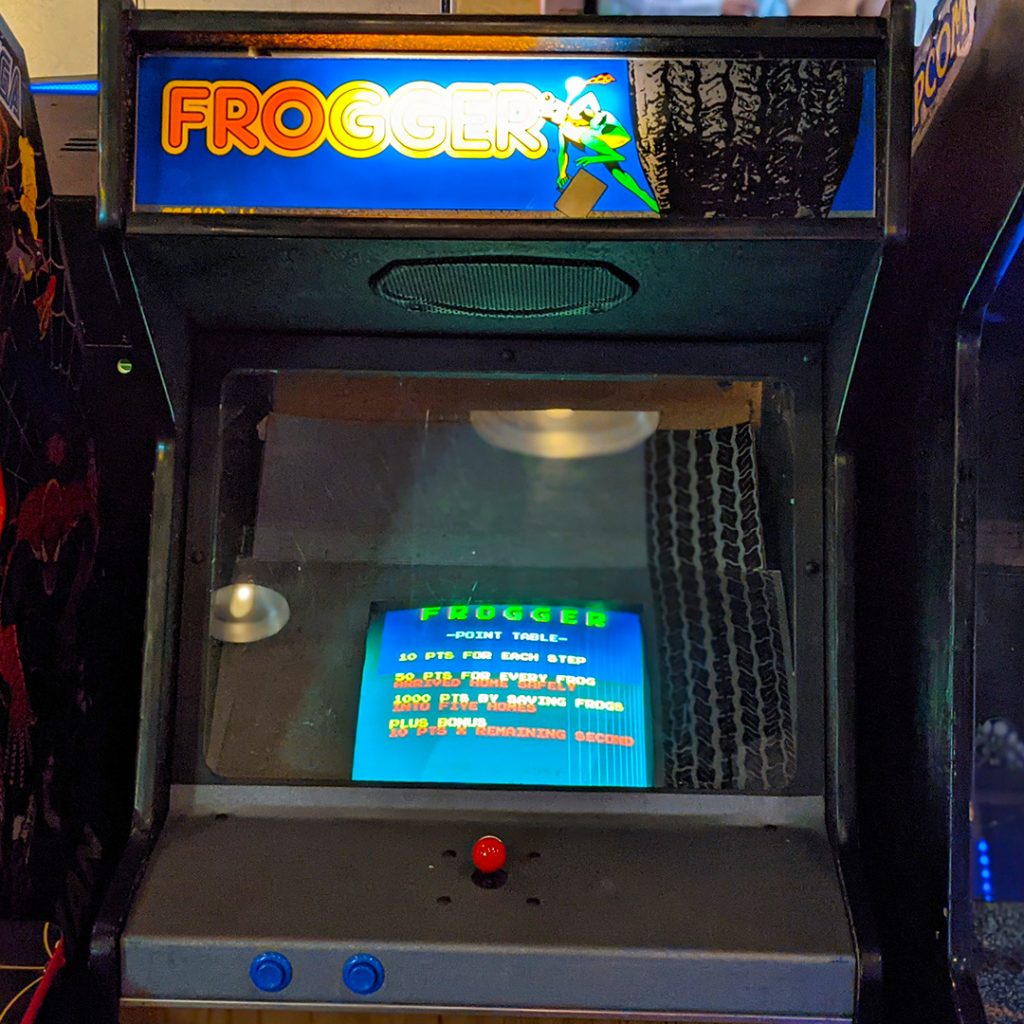
Released: 1982
Publisher: Midway
Developer: General Computer Corporation
Ms. Pac-Man is a 1982 maze arcade game developed by General Computer Corporation and published by Midway. It is the first sequel to Pac-Man (1980) and the first entry in the series to not be made by Namco.
The gameplay is very similar to that of Pac-Man. The player earns points by eating pellets and avoiding ghosts (contact with one causes Ms. Pac-Man to lose a life). Eating an energizer (or “power pellet”) causes the ghosts to turn blue, allowing them to be eaten for extra points. Bonus fruits can be eaten for increasing point values, twice per round. As the rounds increase, the speed increases, and energizers generally lessen the duration of the ghosts’ vulnerability, eventually stopping altogether.
You can read more about Ms. Pac-Man here.
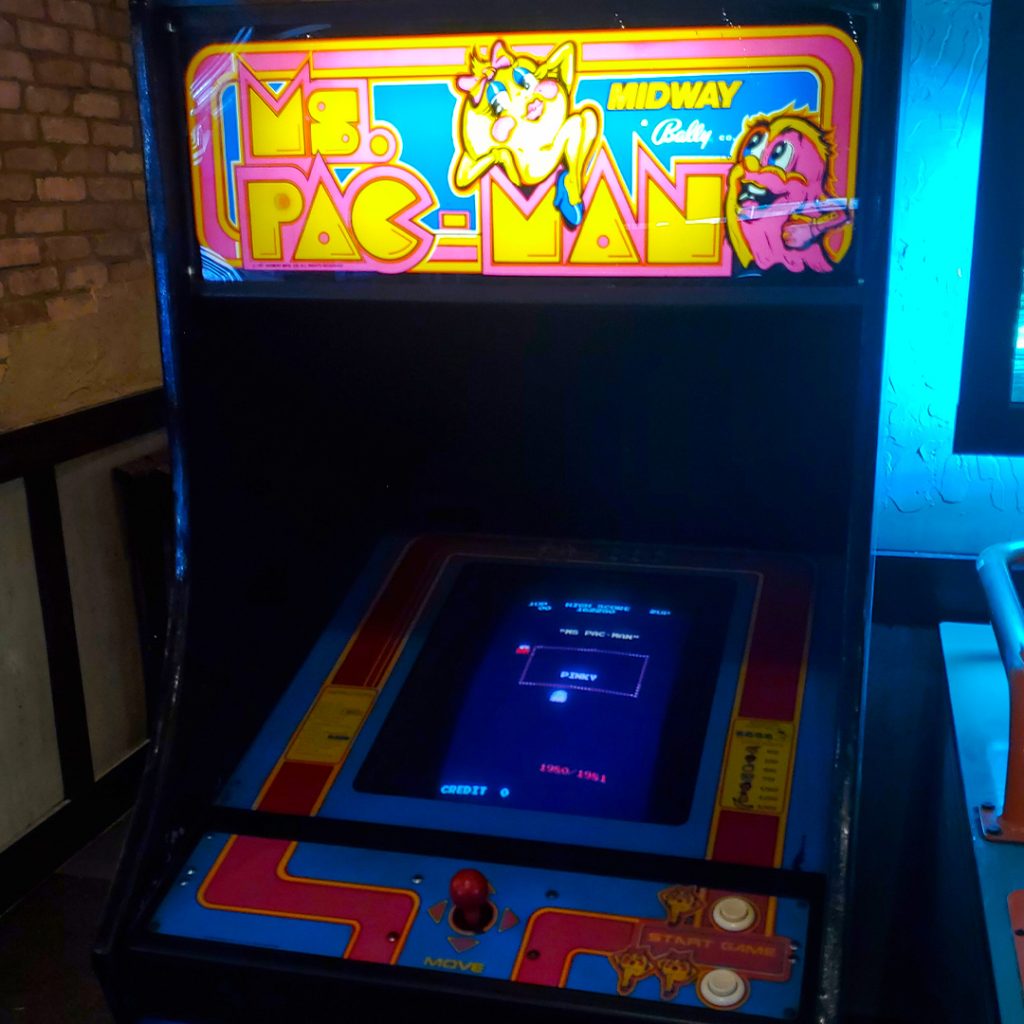
Released: 1981
Publisher: Nintendo
Developer: Nintendo
Donkey Kong is a 1981 arcade video game developed and published by Nintendo. As Mario, the player runs and jumps on platforms and climbs ladders to ascend a construction site and rescue Pauline from the giant gorilla of the same name. It is the first game in the Donkey Kong series as well as Mario’s first appearance in a video game.
Following 1980’s Space Panic, Donkey Kong is one of the earliest examples of the platform game genre, even prior to the term being coined; the U.S. gaming press used ‘climbing game’ for games with platforms and ladders. As the first platform game to feature jumping, Donkey Kong requires the player to jump between gaps and over obstacles or approaching enemies, setting the template for the future of the genre. With its four unique stages, Donkey Kong is the most complex arcade game of the time, and one of the first arcade games with multiple stages, following games such as 1980’s Phoenix and 1981’s Gorf and Scramble.
You can read more about Donkey Kong here.
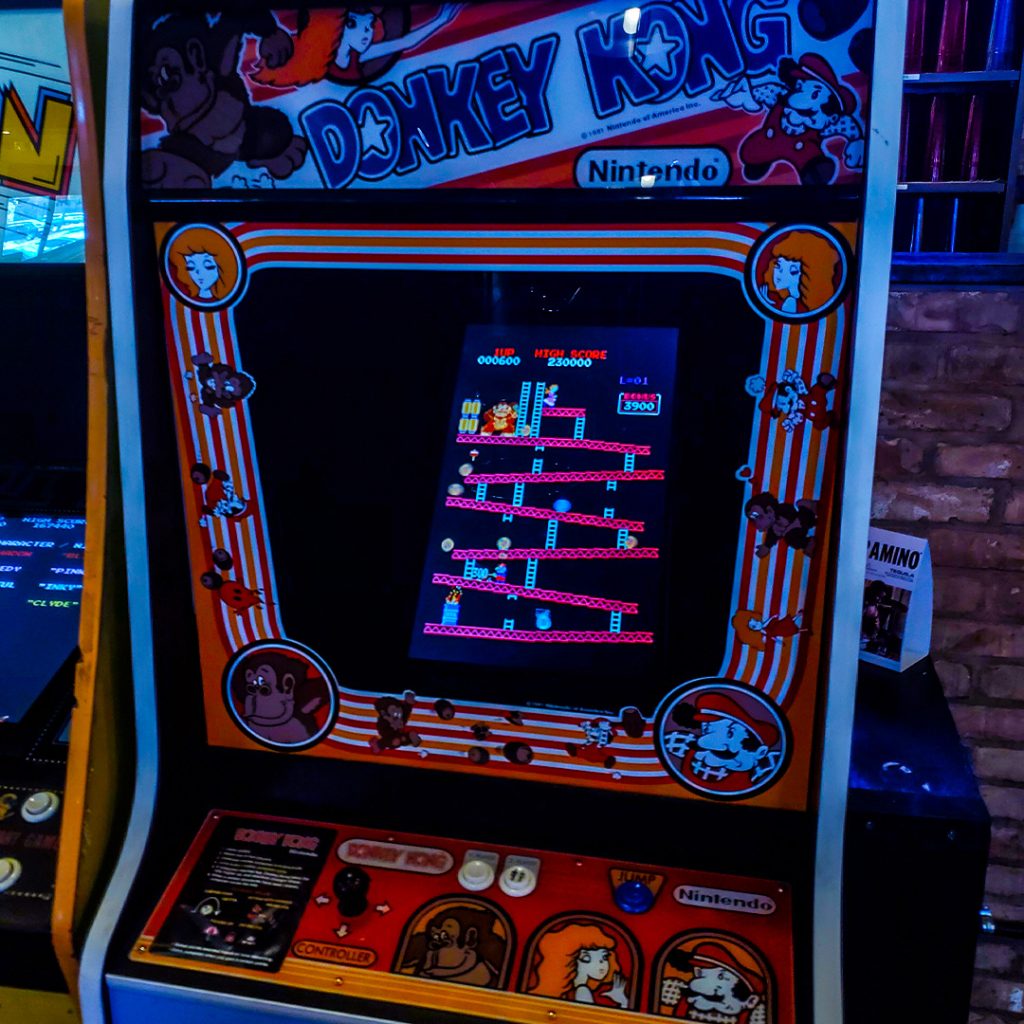
Released: 1987
Publisher: Sega
Developer: Sega AM2
After Burner is an arcade vehicular combat game developed and released by Sega in 1987. The player assumes control of an American F-14 Tomcat fighter jet, and must clear each of the game’s eighteen unique stages by destroying incoming enemies, using both a machine gun and a limited supply of heat-seeking missiles. It uses a third-person perspective, previously utilized by Sega’s earlier games Space Harrier (1985) and Out Run (1986), and runs on the Sega X Board arcade system, which is capable of surface and sprite rotation.
At the start of the game, the player takes off from an aircraft carrier called the SEGA Enterprise on a mission to destroy enemy jets over 18 stages.
In the arcade version, the jet employs a machine gun and a limited number of heat-seeking missiles (in the Master System version the player has unlimited missiles). These weapons are replenished by another aircraft, after beating a few stages. The aircraft, cannon and missile buttons are all controlled from an integrated flight stick.
The game itself was released in two variations in the US: a standard upright cabinet and a closed rotating cockpit deluxe version. In the cockpit version, the seat tilted forward and backwards, and the cockpit rotated from side to side. It featured two speakers at head-level for stereo sound, and had a seatbelt to hold the player when the cockpit moved. Both cabinets contained a grey monitor frame with flashing lights at the top that indicated an enemy’s “lock” on the player’s craft. Japan also received a commander cabinet that moved left and right. A third variation, called commander, released elsewhere, featured an open cabinet.
You can read more about After Burner here.
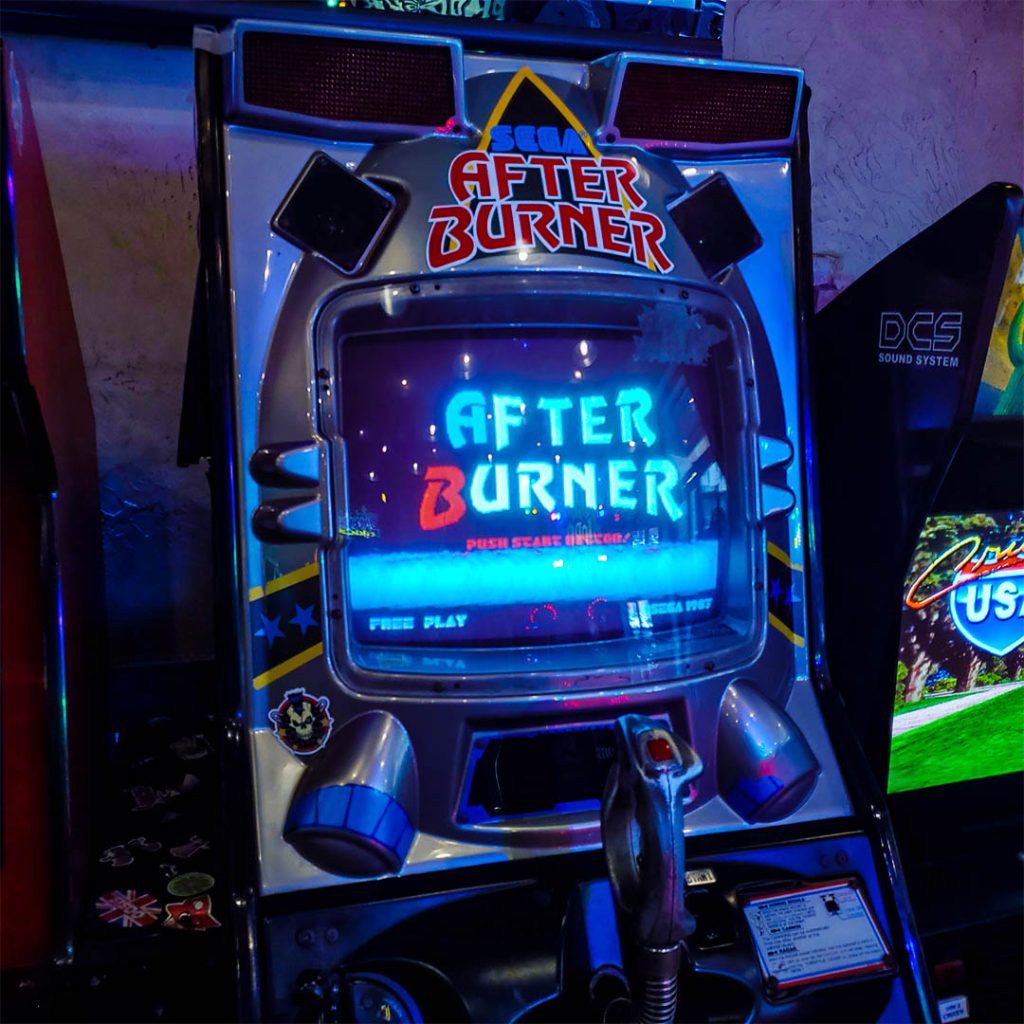
Released: 2021
Publisher: David Murray (The 8-Bit Guy)
Developer: David Murray (The 8-Bit Guy)
Attack of The Petscii Robots is an indie sci-fi top-down action-adventure game developed and published by The 8-Bit Guy for the Commodore 64, Commodore VIC-20, and Commodore PET computers on February 6, 2021. The game can be bought directly from the studio’s website and later received ports to other computers and consoles.
Developed by David Murray (the creator of the YouTube technology channel The 8-Bit Guy, as well as the Planet X series), PETSCII Robots was built to natively support Commodore’s first line of microcomputers (the Commodore PET), with the name PETSCII referring to the platform’s character set of the same name. Similar to Murray’s other games, in-depth “making-of” videos can found on his YouTube channel.
The game is set sometime in the future, where robots attempt to take over human settlements on various planets. Players must infiltrate these settlements and destroy all robots through clever use of items and the environment (such as shooting explosive canisters nearby enemies and moving crates to alter the path of an enemy robot towards a trash compactor).
You can read more about Attack of the Petscii Robots here.
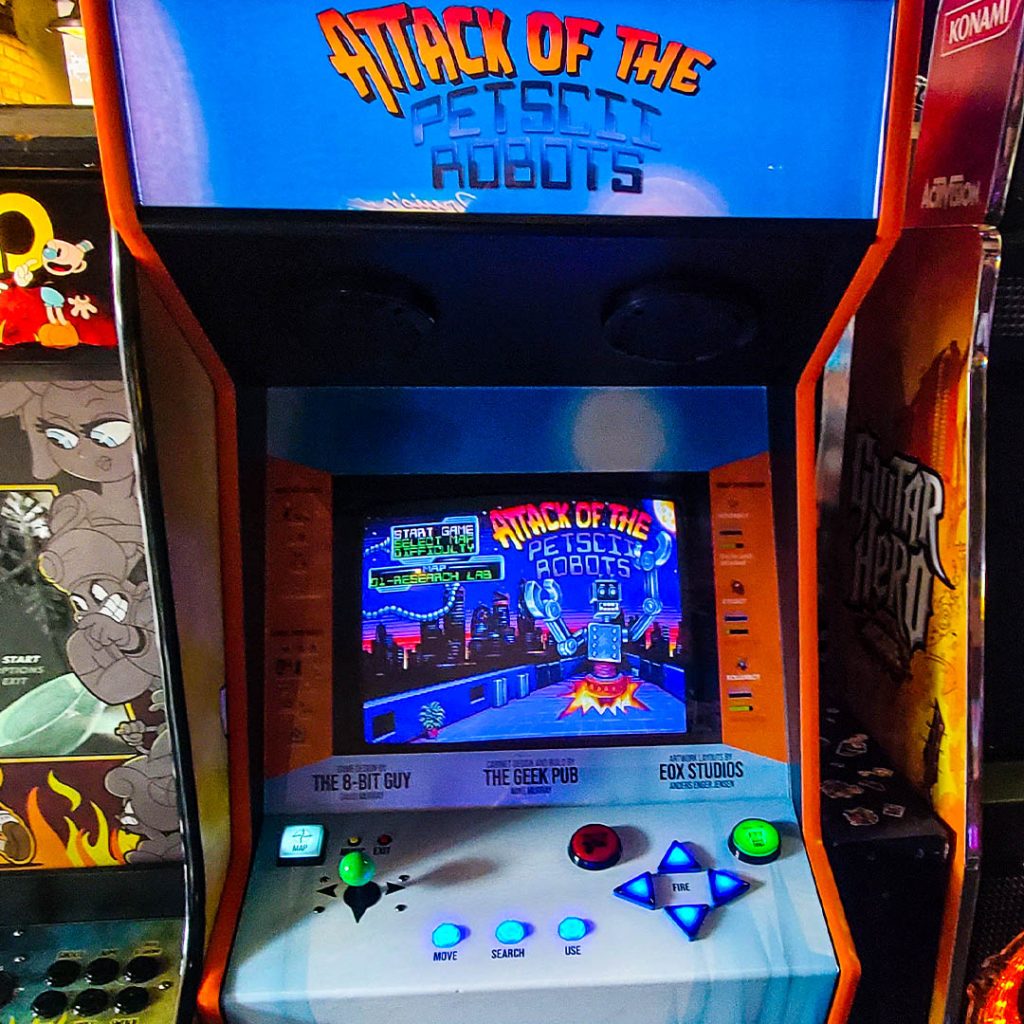
Released: 2008
Publisher: Raw Thrills
Developer: Play Mechanix, Inc
Big Buck: Safari is a hunting video game developed by Play Mechanix, Inc. Primarily developed for arcades, the goal of the game is to shoot moving animals without shooting a female animal.
The Incredible Technologies’ initial series of games from December 2000 – 2005 operated on a single gun platform and allowed four players to compete round robin style through various treks and bonus stages. Raw Thrills’ Big Buck Hunter Pro and Big Buck Safari introduced a two gun platform, allowing head-to-head competition in addition to a variety of new animals and critters to hunt.
Inspired by Duck Hunt, the game’s goal is to shoot the male animals as they run across the screen. The round ends when a female one is shot. Each scene will begin with a couple of animals walking without any suspicions. After a first shot is done, the animals will begin running and the hunt starts. Big Buck Hunter is separated in five screens, also known as “treks”. A hunting sessions concludes in a bonus round. The players can either participate solo or one on one by using two plastic rifles. How much points will be earned depends on certain factors like distance, weight and accuracy.
You can read more about the Big Buck Hunter series, including Big Buck: Safari, here.

Released: 1981
Publisher: Atari, Inc.
Developer: Atari, Inc.
Centipede is a 1981 fixed shooter arcade game developed and published by Atari, Inc. Designed by Dona Bailey and Ed Logg, it was one of the most commercially successful games from the golden age of arcade video games and one of the first with a significant female player base. The primary objective is to shoot all the segments of a centipede that winds down the playing field. An arcade sequel, Millipede, followed in 1982.
The player controls a small insect-like Bug Blaster. It is moved around the bottom area of the screen with a trackball and fires small darts at a segmented centipede advancing from the top of the screen through a field of mushrooms. Each segment of the centipede becomes a mushroom when shot; shooting one of the middle segments splits the centipede into two pieces at that point. Each piece then continues independently on its way down the screen, with the rear piece sprouting its own head. If the centipede head is destroyed, the segment behind it becomes the next head. Shooting the head is worth 100 points while the other segments are 10. The centipede starts at the top of the screen, traveling either left or right. When it touches a mushroom or reaches the edge of the screen, it descends one level and reverses direction. The player can destroy mushrooms (a point each) by shooting them, but each takes four shots to destroy. At higher levels, the screen can become increasingly crowded with mushrooms due to player/enemy actions, causing the centipede to descend more rapidly.
You can read more about Centipede here.

Released: 1999
Publisher: Sega
Developer: Hitmaker
Crazy Taxi is a racing video game developed by Hitmaker and published by Sega. It is the first game in the Crazy Taxi series. The game was first released in arcades in 1999 and then was ported to the Dreamcast in 2000. Gameplay is based on picking up taxi customers and driving to their destination as quickly as possible. Reception to Crazy Taxi has been mostly positive.
The main objective of the game is to pick up customers and take them to their chosen destination as quickly as possible. Along the way, money can be earned by performing stunts, such as near misses with other vehicles. The player is directed to a destination by a large green arrow at the top of the screen. The arrow does not adjust based on obstacles but rather points in the general direction of the destination. Once the player arrives near the destination, they must stop within a specified zone. When the destination is reached, the customer’s fare is added to the player’s total money earned. Ratings are then awarded depending on how long the player took to complete the journey. If the customer’s timer runs out before the player reaches the destination, the customer will jump from the taxi without paying the driver.
You can read more about Crazy Taxi here.
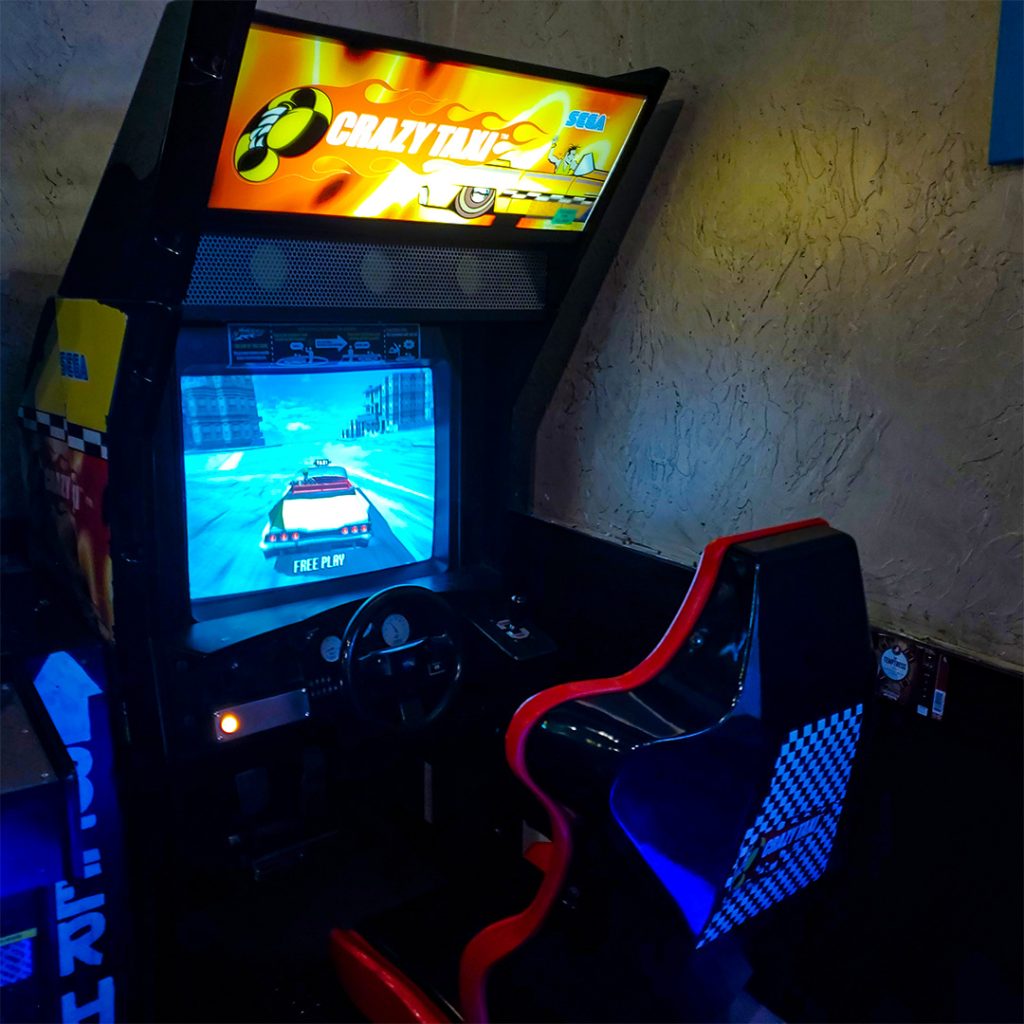
Released: 1999
Publisher: Midway Games
Developer: Midway Games
Cruis’n Exotica is a 1999 racing video game developed for arcades by Midway Games. The game is a sequel to Cruis’n World and is the third entry in the Cruis’n series.
Cruis’n Exotica plays similarly to the previous games in the series, but it adds a PIN system to track progress like San Francisco Rush 2049. The levels take place in exotic locations in the universe, such as Las Vegas, Hong Kong, Atlantis, India, Alaska, The Amazon jungle with dinosaurs, Sahara, Tibet, Korea, Ireland, Holland and the surface of Mars. The game also allows a player to choose a driver visible onscreen during races, including a Martian, a baby, a clown, and a cowboy.
You can read more about Cruis’n Exotica here.
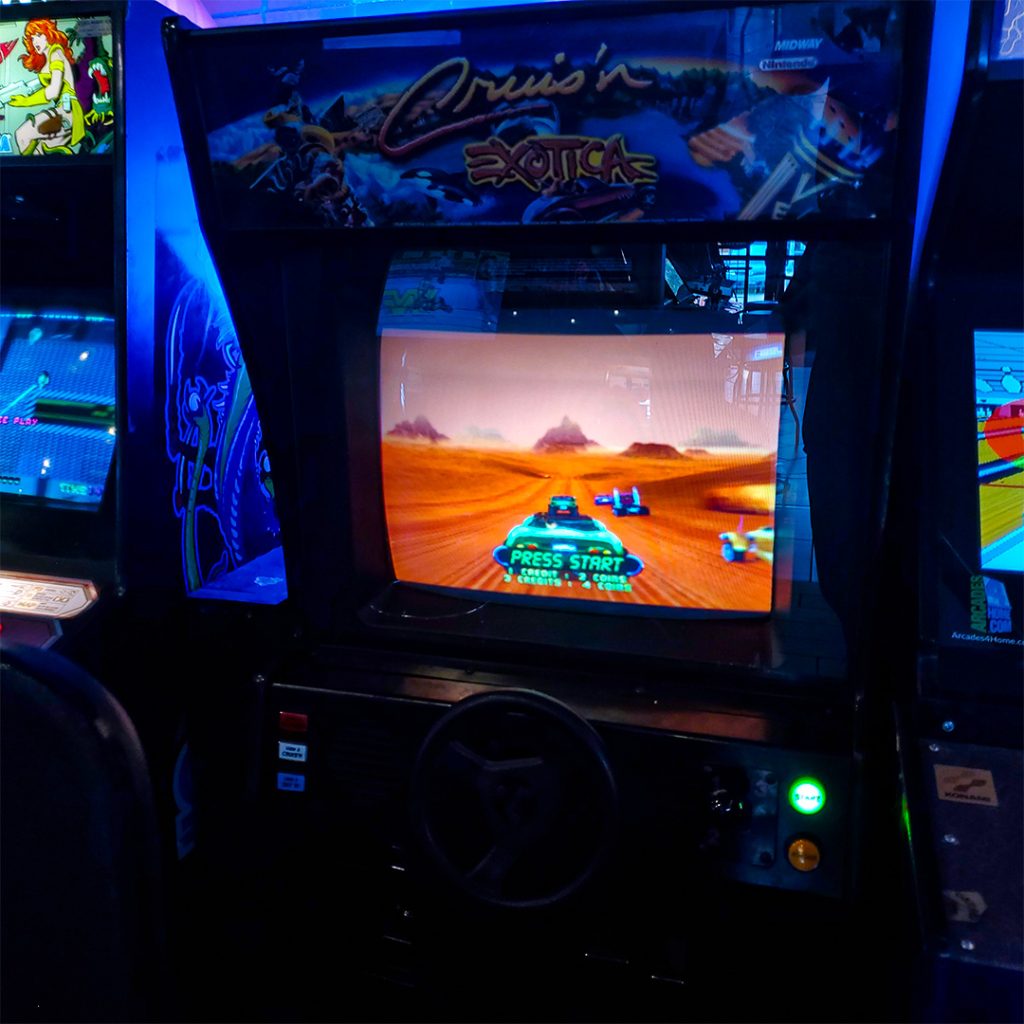
Released: 1994
Publisher: Sega
Developer: Midway/Nintendo
Cruis’n USA is an arcade racing game originally released in 1994. It was developed by Eugene Jarvis’ company TV Games Inc., and manufactured by Midway Games. It is the first game in the Cruis’n series and features races set in locations across the continental United States.
Cruis’n USA is branded as the first release of the “Ultra 64” platform collaboration between Midway and Nintendo, although it was based on the Midway V-unit arcade hardware, predating the Killer Instinct arcade hardware which would become the Nintendo 64. The home port was published by Nintendo as part of the deal.
The arcade version was critically and commercially successful, drawing favorable comparisons to Sega’s Daytona USA. The Nintendo 64 version received poor reviews, but was also commercially successful.
Like in most racing games, players race down one-way courses consisting of streets vaguely based on real-life locations. While racing, they do their best to avoid various road hazards such as oncoming traffic and construction. Players chose between seven different cars, with either an automatic or manual transmission. The environments include Golden Gate Park, in San Francisco, to Washington DC.
In each race, players must reach first place to advance to the next track, and there is a time limit to reach the goal, which can be extended by driving through checkpoints. If the player does not finish before the timer reaches zero, the game ends, unless there is a continue available. Unlike most racing games, there is the option to change the music by pressing the music button.
You can read more about Cruis’n USA here.
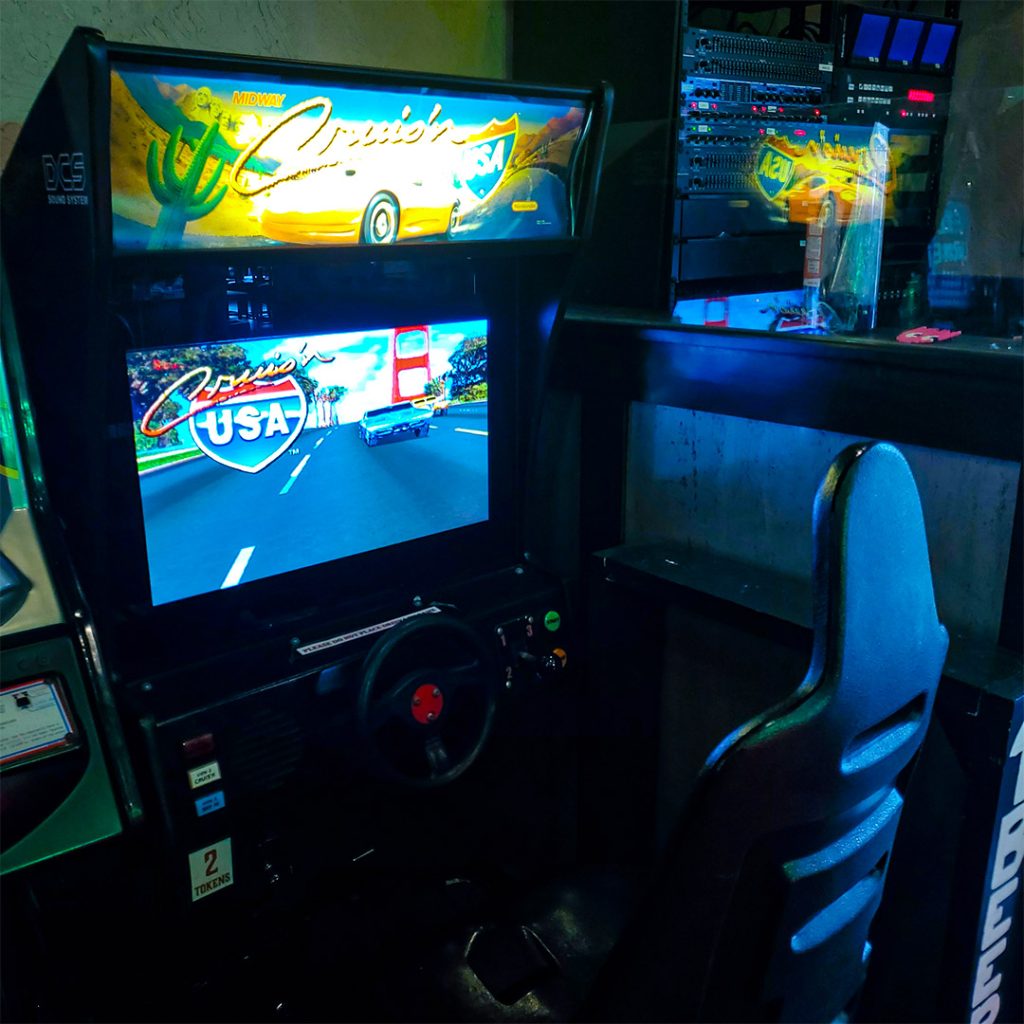
Released: 1984
Publisher: Capcom
Developer: Capcom
1942 is a vertically scrolling shooter game made by Capcom that was released for arcades in 1984. Designed by Yoshiki Okamoto, it was the first game in the 194X series, and was followed by 1943: The Battle of Midway.
1942 is set in the Pacific Theater of World War II, and is loosely based on the Battle of Midway. Despite the game being created by Japanese developers, the goal is to reach Tokyo and destroy the Japanese air fleet; this was due to being the first Capcom game designed with Western markets in mind. It went on to be a commercial success in arcades, becoming Japan’s fifth highest-grossing table arcade game of 1986 and one of top five highest-grossing arcade conversion kits that year in the United States. It was ported to the NES, selling over 1 million copies worldwide, along with other home platforms.
The player pilots a Lockheed P-38 Lightning dubbed the “Super Ace”. The player has to shoot down enemy planes; to avoid enemy fire, the player can perform a roll or vertical loop. During the game, the player may collect a series of power-ups, one of them allowing the plane to be escorted by two other smaller fighters in a Tip Tow formation. Enemies included: Kawasaki Ki-61s, Mitsubishi A6M Zeros and Kawasaki Ki-48s. The boss plane is a Nakajima G10N.
The game has “a special roll button that allows players to avoid dangerous situations by temporarily looping out of” the playfield. In addition to the standard high score, it also has a separate percentage high score, recording the best ratio of enemy fighters to enemies shot down.
You can read more about 1942 here.
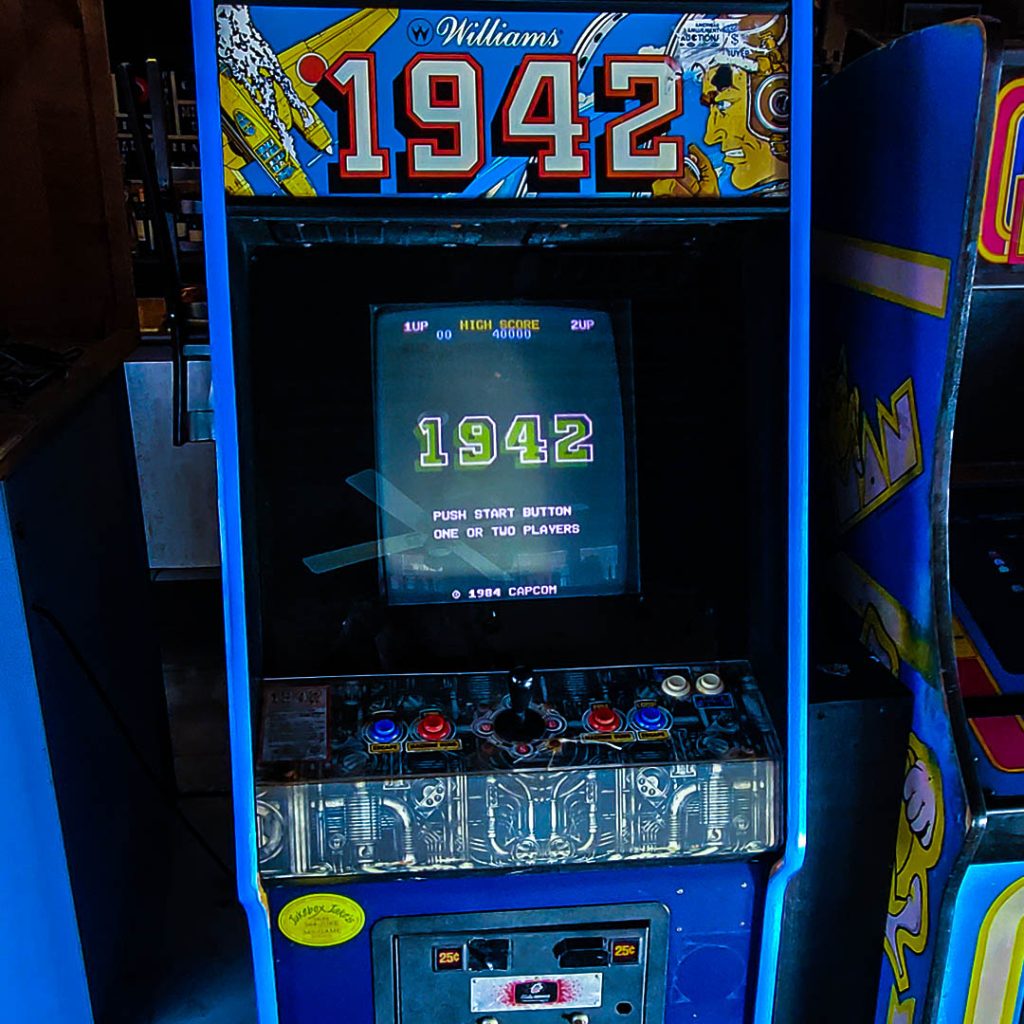
Released: 1987
Publisher: Sega
Developer: Sega
Alien Syndrome (エイリアンシンドローム, Eirian Shindorōmu) is a run and gun game developed by Sega and released in arcades in 1987.
Two players control two soldiers, named Ricky and Mary, who fight their way through large eight-way scrolling levels while rescuing their comrades who are being held by aliens. After they have rescued a certain number of hostages, the exit opens and they can pass through it in order to fight the end-of-level guardian. If this monstrosity is defeated, they are then able to move onto the next stage. Alien Syndrome features two player simultaneous gameplay and pickups which assist the player, including better weapons and maps of the current level.
In 1988, the game was ported to the Master System, MSX, Amiga, Atari ST, Amstrad CPC, Commodore 64, and Famicom/Nintendo Entertainment System (published by Tengen without a Nintendo license). Later, the game was ported to the ZX Spectrum (1989), Game Gear (1992), and X68000 (1992).
You can read more about Alien Syndrome here.
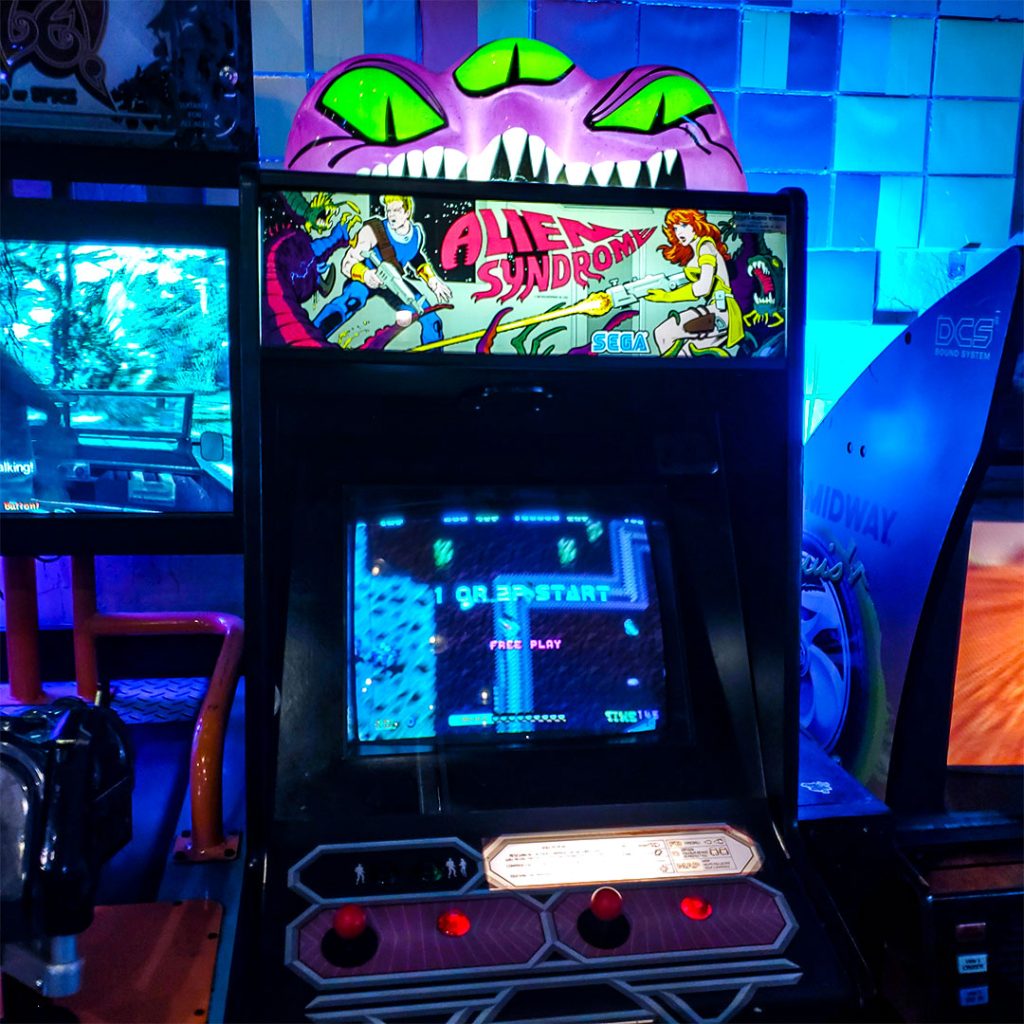
Released: 1989
Publisher: Midway
Developer: Midway
Arch Rivals is a basketball sports video game released by Midway for arcades in 1989. Billed by Midway as “A Basket Brawl”, the game features two-on-two full court basketball games in which players are encouraged to punch opposing players and steal the ball from them. Arch Rivals was the second basketball video game released by Midway, sixteen years after TV Basketball (1974).
Arch Rivals allows players to select from a variety of fictional teams (although arcade operators can change the team names to reflect real ones) and players. One playable character, “Tyrone” was also featured in the animated The Power Team segments of the television series Video Power. In turn, the game has been considered a forerunner to Midway’s popular arcade basketball game, NBA Jam.
Games generally follow standard basketball rules; a full game consists of four quarters, with four minutes each. Each team has two players, and the objective of the game is to outscore the opponent until the final buzzer sounds. A player can call for his teammate to pass him the ball or to shoot it in this battle royale.
If the game results in a tie after four quarters, multiple sudden death overtime periods are added, in which case whoever scores the next basket will win the game. Every overtime period is one minute. If, however, no score occurs after overtime the procedure repeats.
You can read more about Arch Rivals here.
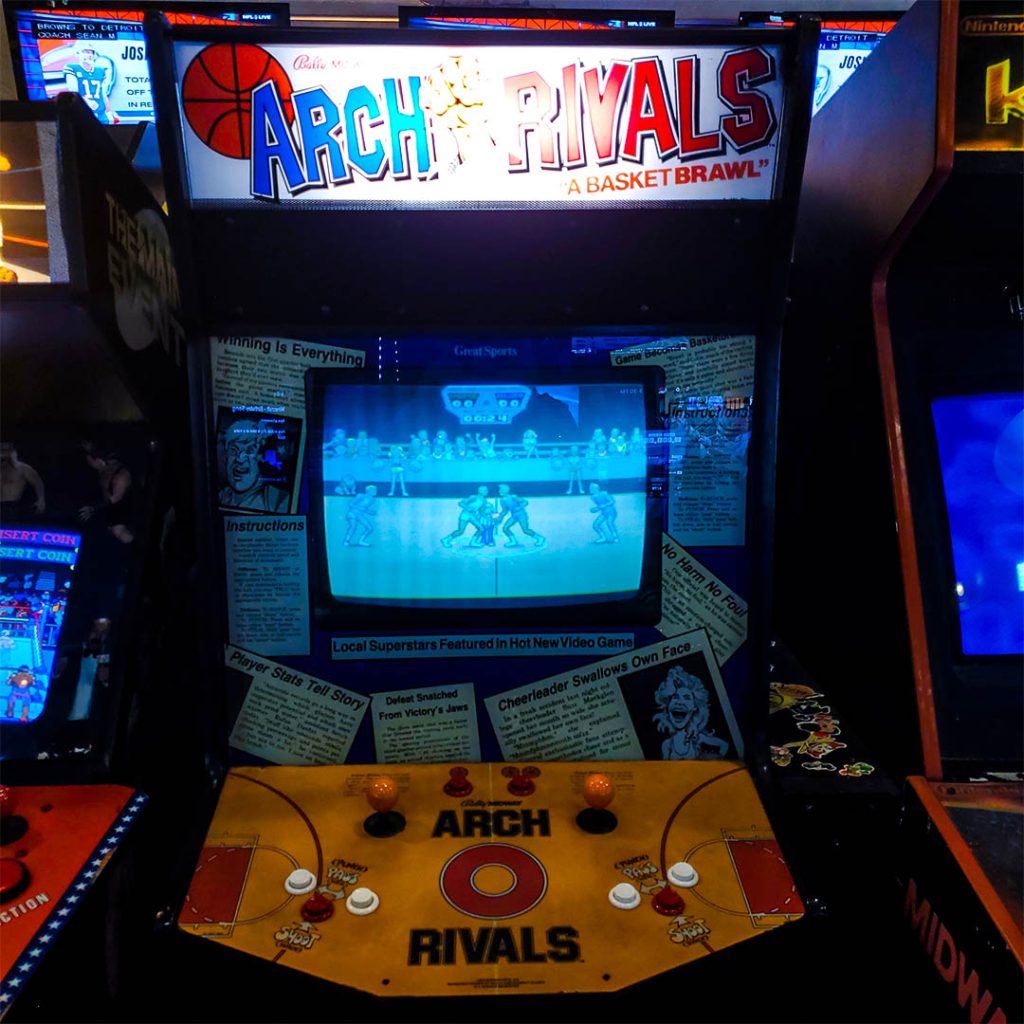
Released: 1979
Publisher: Atari, Inc.
Developer: Atari, Inc.
Asteroids is a space-themed multidirectional shooter arcade video game designed by Lyle Rains and Ed Logg released in November 1979 by Atari, Inc. The player controls a single spaceship in an asteroid field which is periodically traversed by flying saucers. The object of the game is to shoot and destroy the asteroids and saucers, while not colliding with either, or being hit by the saucers’ counter-fire. The game becomes harder as the number of asteroids increases.
Asteroids was conceived during a meeting between Logg and Rains, who decided to use hardware developed by Howard Delman previously used for Lunar Lander. Asteroids was based on an unfinished game titled Cosmos; its physics model, control scheme, and gameplay elements were derived from Spacewar!, Computer Space, and Space Invaders and refined through trial and error. The game is rendered on a vector display in a two-dimensional view that wraps around both screen axes.
Asteroids was one of the first major hits of the golden age of arcade games; the game sold over 70,000 arcade cabinets and proved both popular with players and influential with developers. In the 1980s it was ported to Atari’s home systems, and the Atari VCS version sold over three million copies. The game was widely imitated, and it directly influenced Defender, Gravitar, and many other video games.
The objective of Asteroids is to destroy asteroids and saucers. The player controls a triangular ship that can rotate left and right, fire shots straight forward, and thrust forward.[7] Once the ship begins moving in a direction, it will continue in that direction for a time without player intervention unless the player applies thrust in a different direction. The ship eventually comes to a stop when not thrusting. The player can also send the ship into hyperspace, causing it to disappear and reappear in a random location on the screen, at the risk of self-destructing or appearing on top of an asteroid.
You can read more about Asteroids here.
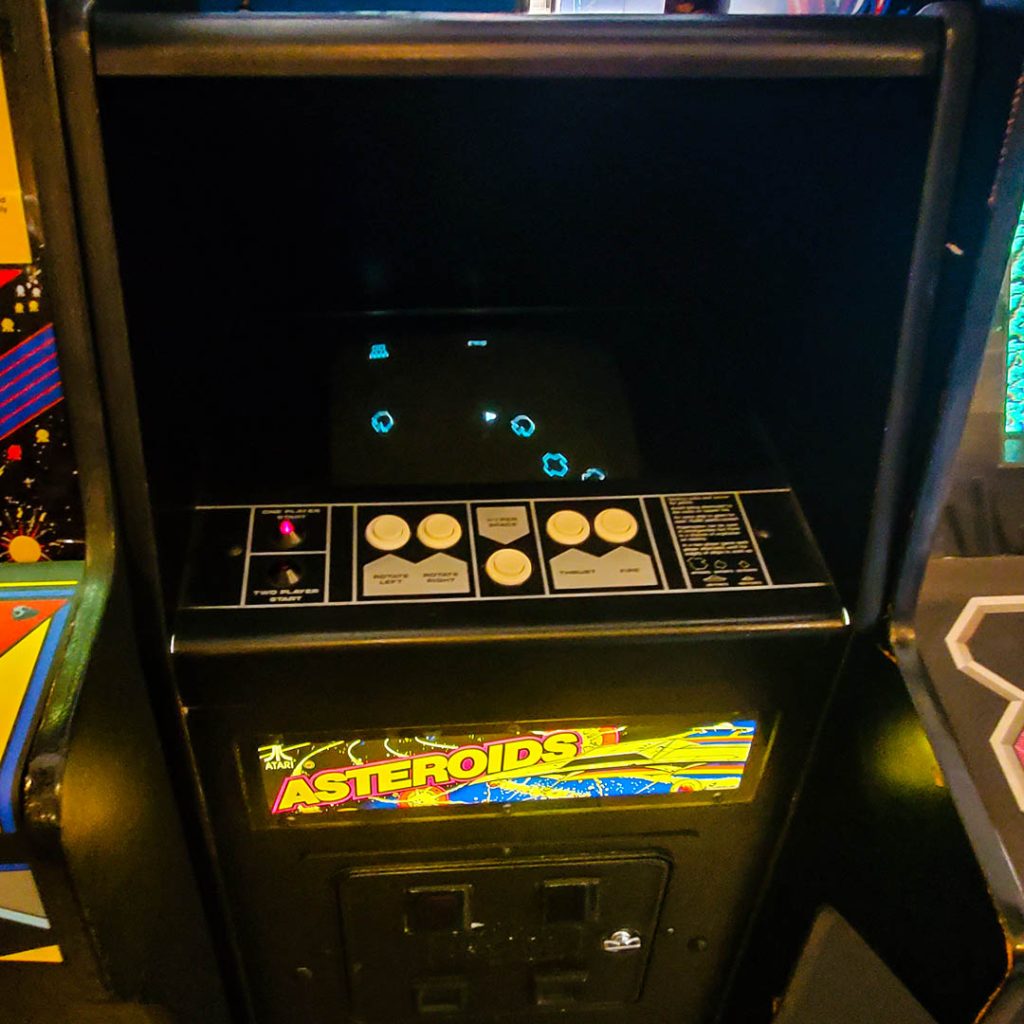
Released: 2017
Publisher: Studio MDHR
Developer: Studio MDHR
Cuphead is a run-and-gun video game developed and published by Studio MDHR. The game follows the titular Cuphead who, in a deal with the Devil after losing a game at the Devil’s casino, is sent on a quest to repossess the souls of runaway debtors as payment for Cuphead’s loss. In the game, up to two players control Cuphead and/or his brother Mugman to fight through several levels and boss fights; the game does not have a rigid narrative structure. As the game progresses, the protagonist acquires more power and abilities, eventually threatening the Devil himself. Players, however, can only equip a limited number of these abilities at a given time.
The game’s creators, brothers Chad and Jared Moldenhauer, took inspiration from the rubber hose style of the golden age of American animation and the surrealist qualities of works of Walt Disney Animation Studios, Fleischer Studios, Warner Bros. Cartoons, MGM Cartoon Studio and Walter Lantz Productions. Reminiscent of the ’30s aesthetics and Jazz Age, the game is noted for its animation and soundtrack: all in-game assets used hand-drawn animation with deliberate human imperfections, and the soundtrack was written for and recorded with a full jazz ensemble.
Cuphead‘s gameplay is centered on continual boss fights, interspersed with run-and-gun levels. Each is housed in one of four worlds, with the final fight against the Devil. Each boss fight includes a simple, regular, and expert difficulty mode (with the exception of the final two bosses, which lack a simple mode). Defeating a boss on normal mode is required to progress through the game and unlocks expert mode for that particular level. Most boss battles take place on land, although some involve player characters piloting aeroplanes and play like a side-scrolling shoot ’em up. The game includes role-playing elements and a branching level sequence. Player characters have infinite lives, maintaining all equipment between deaths. Equippable weapons and special abilities, referred to as Charms, can be purchased from Porkrind’s Emporium, an in-game shop, using coins found in levels and the overworld. Player characters can use a slapping parry attack on objects marked in pink to various effects, the most important of them being a super meter charge that enables more powerful attacks. The super meter is represented by a row of five playing cards, and can also be charged through attacking or Charm effects. An enhanced attack can be executed at the cost of one card, with its particular form determined by the currently equipped weapon. The most powerful strikes, or Super Arts, require the Super Meter to be fully charged and will completely drain it upon use. Three Super Arts are available, one in each of the first three worlds; to earn each one, the player must enter a mausoleum and parry a horde of ghosts to stop them from reaching an urn at the center of the screen.
You can read more about Cuphead here.
The Cuphead Arcade cabinet at Black Dog Retro Arcade was specially made for the arcade and is one of a kind! Be sure to check it out on your next visit!
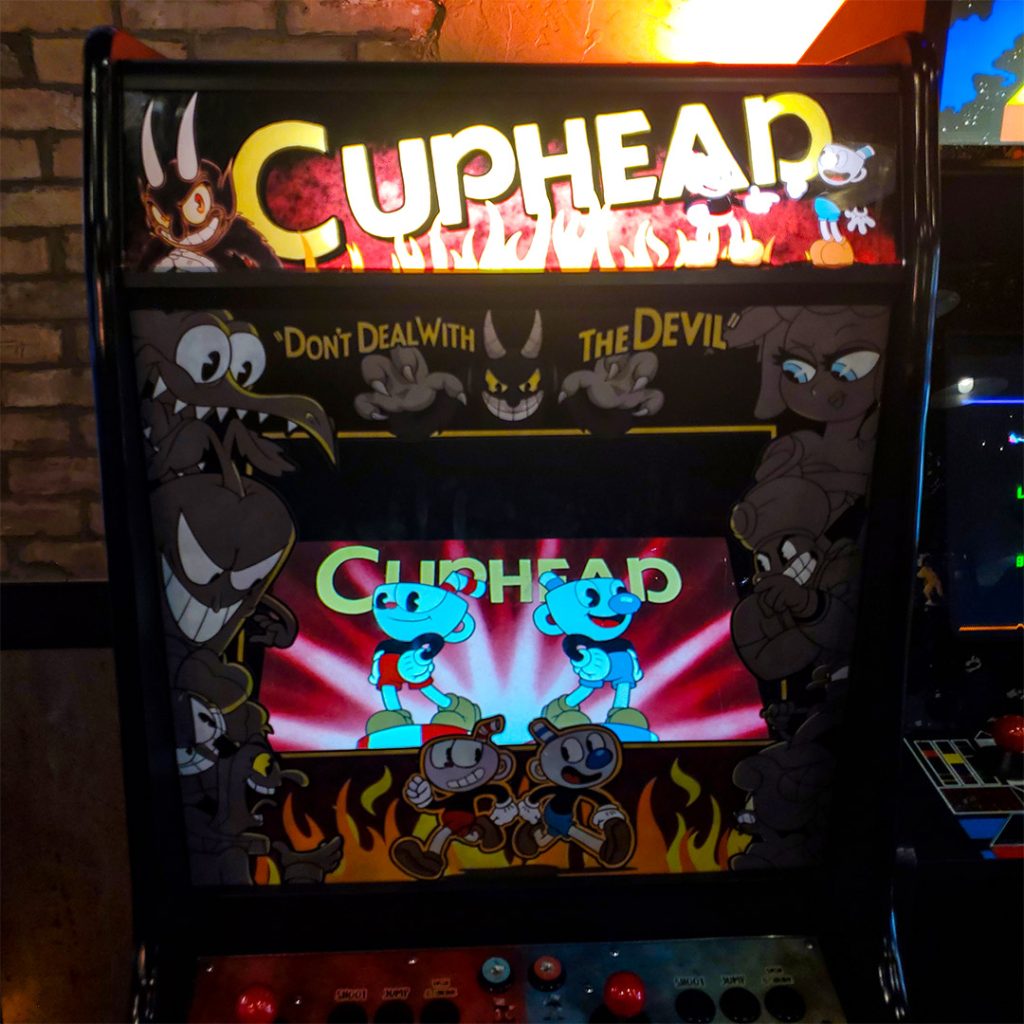
Released: 2008
Publisher: Konami
Developer: Konami
Dance Dance Revolution SuperNova 2, sometimes abbreviated as DDR SN2, was released on August 22, 2007 by Konami to Japanese arcades and on February 21, 2008 for the PlayStation 2 counterpart. In North America, a slightly different PlayStation 2 version was released first on September 25, 2007 before that region’s arcade release on January 17, 2008. It is the final arcade release to be powered by the PlayStation 2 by means of the Python 2 arcade board.
SuperNova 2 features some changes to the series. It introduces a new scoring system that is retained in all future installments. The score cap is 1,000,000 and factors in Marvelous timing, making it an integral part of the gameplay instead of being restricted to courses. A full combo is not a prerequisite for AA or AAA ratings, which are now determined solely by score.
The game adds several new options, including 0.25x and 0.5x speed, Brake (arrows slow down when they are about to reach the Step Zone) and Wave (arrows bounce up and down as they reach the Step Zone, similar to a wave). Aesthetic additions include unique arrow shapes, character cut-ins which happen if players reach certain combo milestones, and a small marquee which displays the song title and artist during gameplay. It is also one of the few arcade DDR games which provides everyone with a character select screen before the gameplay proper; later games would restrict this to e-Amusement players. The mode selection from SuperNova has been simplified to offering just six options; Easy, Medium, and Difficult modes are replaced with “Beginner”, which provides a limited selection of the song list, while All Music is renamed “Standard”.
The game retains the same core gameplay of the series. During gameplay, arrows scroll from the bottom to the top of the screen towards stationary arrows known as the “Step Zone”. Once they reach the zone, players step on the dance pad corresponding to the arrows and the game will then judge the accuracy of the timing. The rankings are as follow: “Marvelous”, “Perfect”, “Great”, “Good”, “Almost”, and “Boo”. The last two rankings are taken from the North American games and differ from the ones used for DDR Extreme, which respectively has “Boo” and “Miss”.
You can read more about the Dance Dance Revolution series here and more about DDR SN2 here.

Released: 1981
Publisher: Williams Electronics
Developer: Williams Electronics
Defender is a scrolling shooter video game developed by Williams Electronics in 1980 and released for arcades in 1981. A side-scrolling shooter, the game is set on either an unnamed planet or city (depending on platform) where the player must defeat waves of invading aliens while protecting astronauts. Development was led by Eugene Jarvis, a pinball programmer at Williams; Defender was Jarvis’ first video game project and drew inspiration from Space Invaders and Asteroids. Defender was demonstrated in late 1980, before entering production in early 1981. It was distributed in Japan by Taito.
Defender was one of the most important titles of the golden age of arcade video games, selling over 55,000 units to become the company’s best-selling game and one of the highest-grossing arcade games ever. Praise among critics focused on the game’s audio-visuals and gameplay. It is frequently listed as one of Jarvis’ best contributions to the video game industry and one of the most difficult video games. Though not the first game to scroll horizontally, it created the genre of purely horizontal scrolling shoot ’em ups. It inspired the development of other games and was followed by sequels and many imitations.
Several ports were developed for contemporary game systems, most of them by either Atari, Inc. or its software label for non-Atari platforms, Atarisoft.
Defender is a side-view, horizontally scrolling shooter set on the surface of an unnamed planet. The player controls a spaceship flying either to the left or right. A joystick controls the ship’s elevation, and five buttons control its horizontal direction and weapons. The player starts with three “smart bombs”, which destroy all visible enemies. As a last resort, the “hyperspace” button works as in Asteroids: the player’s ship reappears in a random—possibly unsafe—location. Players are allotted three ships at the start of the game; another ship and smart bomb are awarded every 10,000 points (adjustable per machine). Two players can alternate turns.
The object is to destroy all alien invaders, while protecting astronauts on the landscape from abduction. Landers pick up humans and attempt to carry them to the top of the screen at which point they turn into fast-moving mutants. A captured human can be freed by shooting the lander, then catching the human before it falls to its death, and dropping it off on the ground.
Defeating the aliens allows the player to progress to the next level. Failing to protect the astronauts, however, causes the planet to explode and the level to become populated with mutants. Surviving the waves of mutants results in the restoration of the planet. A ship is lost if it is hit by an enemy or its projectiles, or if a hyperspace jump goes wrong (as they randomly do). After exhausting all ships, the game ends.
You can read more about Defender here.
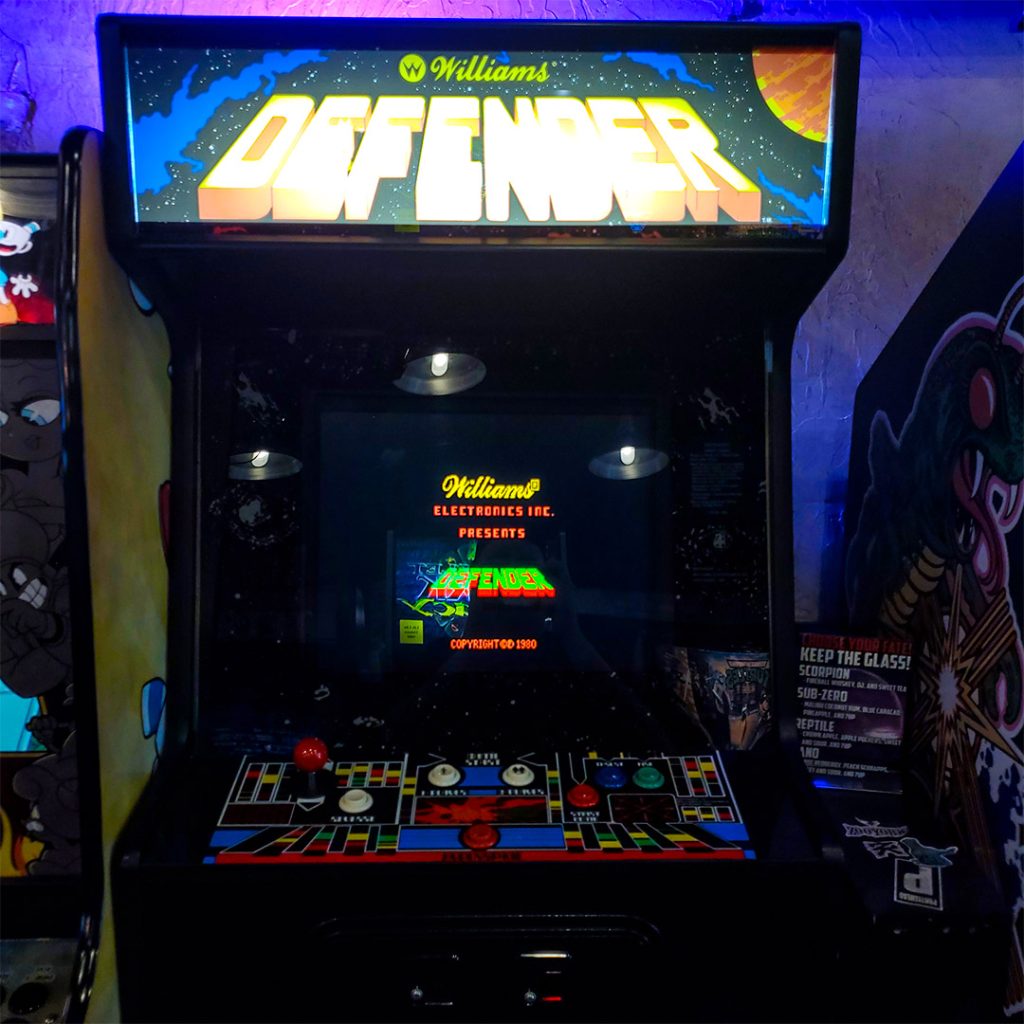
Released: 1982
Publisher: Nintendo
Developer: Nintendo R&D1
Donkey Kong Jr. is a 1982 arcade platform game that was released by Nintendo. It is the sequel to Donkey Kong, but with the roles reversed compared to its predecessor: Mario (previously named “Jumpman”) is now the villain and Donkey Kong Jr. is trying to rescue his father. It first released in arcades and, over the course of the decade, was released for a variety of home platforms. The game’s title is written out as Donkey Kong Junior in the North American arcade version and various conversions to non-Nintendo systems.
The game was principally designed by Shigeru Miyamoto and his coworker and the company’s chief engineer Gunpei Yokoi. Miyamoto also created the graphics for the title along with Yoshio Sakamoto. As with its predecessor, the music for the game was composed by Yukio Kaneoka.
Like its predecessor, Donkey Kong Jr. is a platform game. There are a total of four stages, each with a unique theme. DK Jr. can run left and right, jump, and grab vines/chains/ropes to climb higher on the screen. He can slide down faster by holding only one vine, or climb faster by holding two. Enemies include “Snapjaws”, which resemble bear traps with eyes; bird-like creatures called “Nitpickers”, some of which can attack by dropping eggs; and “Sparks” which roam across the wiring in one of Mario’s hideouts. DK Jr. can jump over these enemies while on platforms, switch from one vine/chain/rope to another to dodge them, or knock down pieces of fruit that will destroy every enemy they touch before falling off the bottom of the screen.
To pass the first three stages, DK Jr. must reach the key hanging next to his father’s cage, whereupon Mario flees while pushing the cage off the screen. In the fourth stage, DK Jr. must push six keys into locks on the topmost platform to free Donkey Kong. After a brief cutscene, the player is taken back to the first stage at an increased difficulty. A bonus timer runs throughout each stage, and any points remaining on it are added to the player’s score upon completion.
DK Jr. loses a life when he touches any enemy or projectile, falls too great a distance, touches the water and falls off the bottom of the screen or if the bonus timer counts down to zero. The game ends when the player loses all of their lives.
You can read more about Donkey Kong Jr. here.
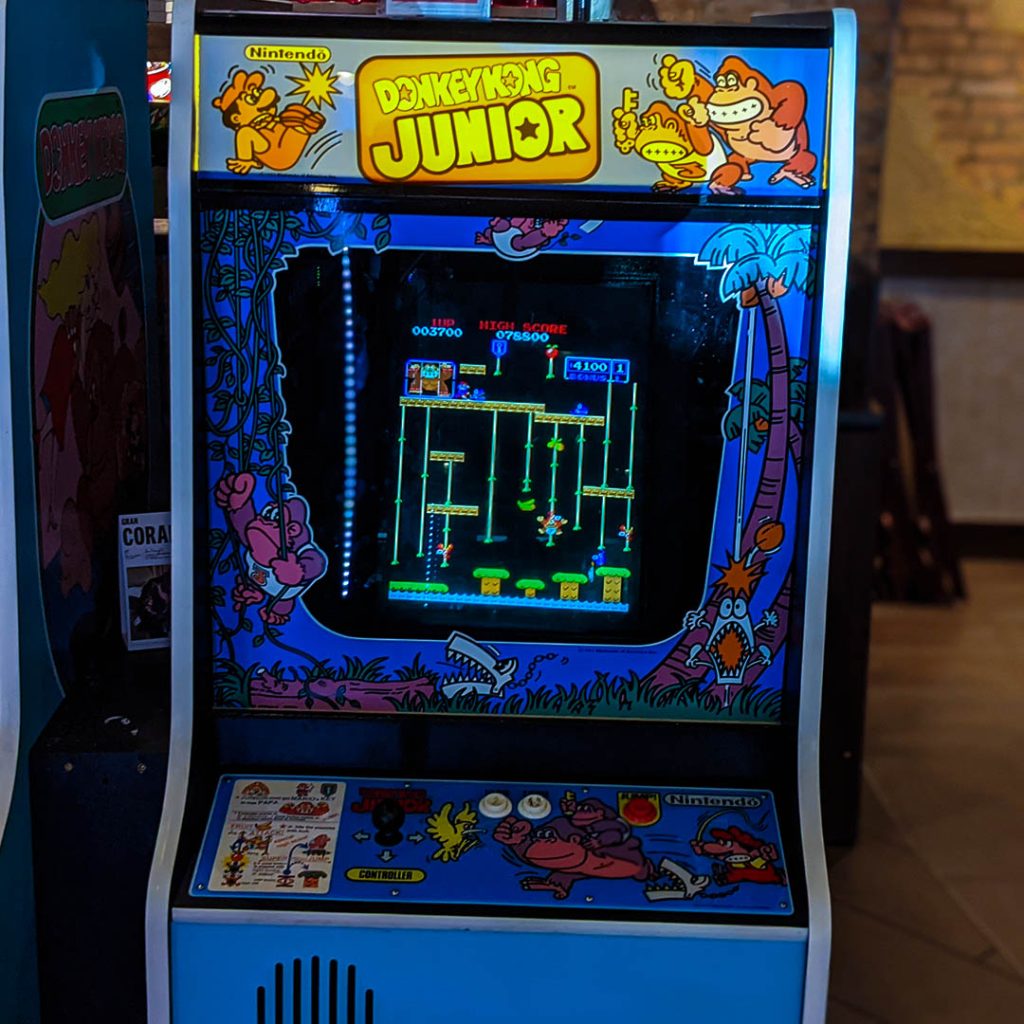
Released: 1981
Publisher: Namco / Midway
Developer: Namoc
Galaga is a 1981 fixed shooter arcade video game developed and published by Namco. In North America, it was released by Midway Manufacturing. It is the sequel to Galaxian (1979), Namco’s first major video game hit in arcades. Controlling a starship, the player is tasked with destroying the Galaga forces in each stage while avoiding enemies and projectiles. Some enemies can capture a player’s ship via a tractor beam, which can be rescued to transform the player into a “dual fighter” with additional firepower.
Galaga is a fixed shooter. The player mans a lone starfighter at the bottom of the screen, which must prevent the Galaga forces from destroying all of mankind. The objective of each stage is to defeat all of the Galaga aliens, which will fly into formation from the top and sides of the screen. Similar to Galaxian, aliens will dive towards the player while shooting down projectiles; colliding with either projectiles or aliens will result in a life being lost.
Atop the enemy formation are four large aliens known as the “Boss Galaga”, which take two shots to destroy. These aliens can use a tractor beam to capture the player’s ship, returning with it to the top of the formation and costing the player a life. Should additional lives remain, the player has an opportunity to shoot down the Boss Galaga holding the captured ship. Shooting it down as it dives towards the player will result in the captured ship being rescued, and it will join the player’s ship, transforming it into a “dual-fighter” with additional firepower and a larger hitbox. However, destroying a Boss Galaga with a captured ship while it is in formation will instead cause the fighter to turn against the player and act as an alien. The ship will return in a later level as part of the formation.
Some enemies can morph into new enemy types with different attack patterns, with one even taking the form of the Galaxian Flagship. Stages are indicated by emblems located at the bottom-right of the screen. Enemies become more aggressive as the game progresses, increasing their number of projectiles and diving down at a faster rate. The third stage and every fourth thereafter is a bonus stage, where the aliens fly in a preset formation without firing at the player.
You can read more about Galaga here.

Released: 1999
Publisher: Midway Games
Developer: Midway Games West
Gauntlet Dark Legacy is a video game originally released to arcades in 1999. It is the sixth title in the Gauntlet series, and is an expansion of the previous title in the series, Gauntlet Legends. The expansion adds five new levels, and four new character classes: Dwarf, Knight, Jester, and Sorceress. It also adds a large number of secret characters, some of which can be unlocked in the game, while others are only accessible by entering specific cheat codes.
Elements from Dark Legacy were integrated into the Dreamcast port of Gauntlet Legends. A direct port to the PlayStation 2 was released in 2001, followed by versions for the Game Boy Advance, GameCube, and Xbox released in 2002.
A GBC port was considered but never released by Midway.
The gameplay has roots in the original Gauntlet games. Most levels involve simply running along a designated path, destroying enemies before they can kill the player. Like in Gauntlet and Gauntlet II, enemies spawn from generators. Only when the generator is destroyed will the enemies stop spawning. Some generators will take multiple hits to destroy; as the generator is weakened, it will spawn less powerful enemies, until it is destroyed completely. There are some levels that have a maze-like aspect and are harder to navigate. Generally, levels have the path to the end easily in sight, with separate side paths that are harder to access. These side paths usually lead to important items, such as treasure, legendary weapons (which are used to weaken bosses), or runestones (which are required to progress through the game). Some levels will have a short movie before the level loads, serving to introduce the player to new types of enemies, or alerting the player that a legendary weapon is hidden somewhere in the level. Runestones are not hinted at in movies, though if a level that has a runestone is exited without the runestone being found, an evil laugh sound is played. Food still recovers health in Dark Legacy as it did in Gauntlet II, with each type of food restoring a different amount of health. Treasure is a rarity in Dark Legacy, as it is used to purchase items in the shop. This is a difference from the earlier Gauntlet games, where treasure was plentiful, giving extra points, but not serving any other purpose.
You can read more about Gauntlet Dark Legacy here.
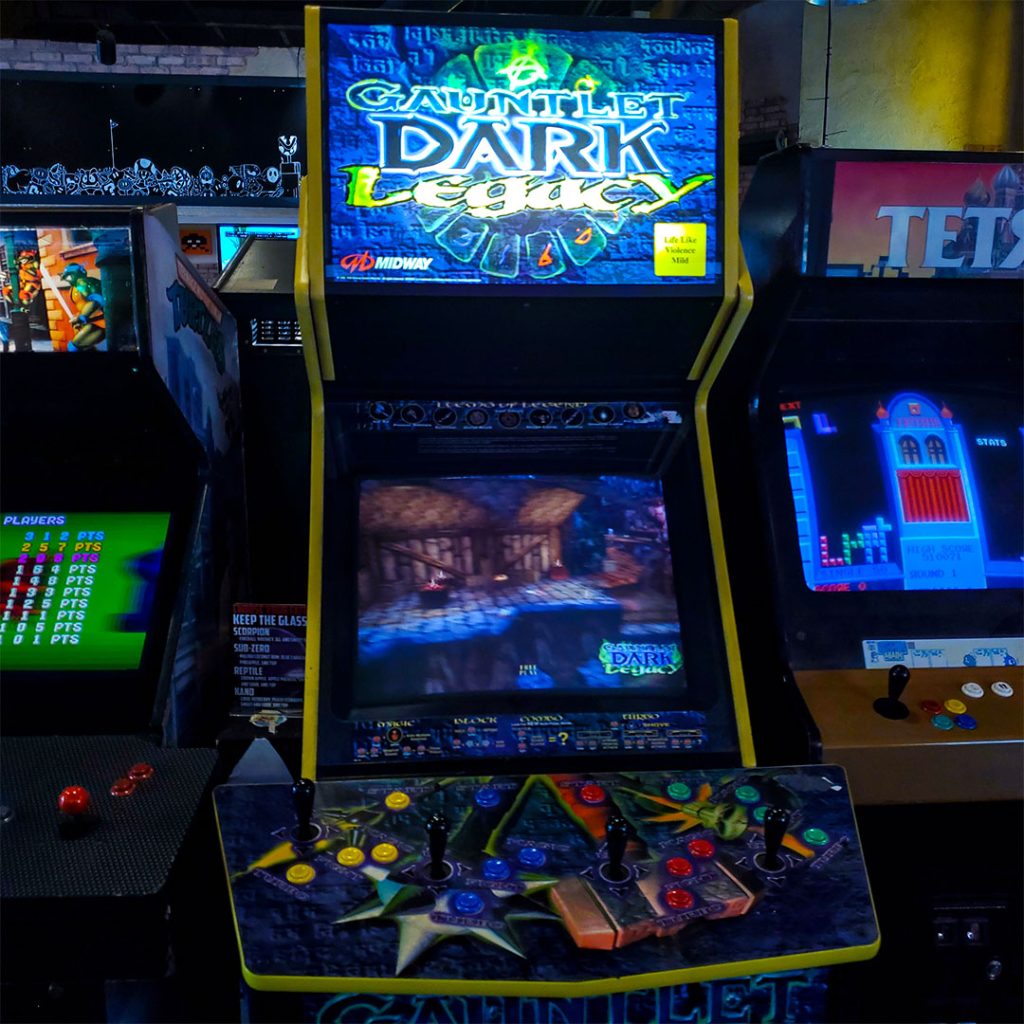
Released: 1989
Publisher: Incredible Technologies
Developer: Incredible Technologies
Golden Tee Golf is a golf arcade game series by Incredible Technologies. Its signature feature is the use of a trackball to determine the power, direction and curve of the player’s golf shot. Play modes include casual 18-hole golf, closest to the pin, and online tournaments. One of the longest running arcade game series, Golden Tee has maintained a large following and spawned a competitive tournament scene.
The Golden Tee series began as a project at Incredible Technologies to create a large scale golf simulator for sizable family entertainment centers. The idea was scrapped, but not before programmer Larry Hodgson had already written software to create virtual golf courses. Rather than discard his work, Hodgson retooled the concept to develop a golf game for regular arcade cabinets. He worked with co-designer Jim Zielinski, who initially rendered the courses using Deluxe Paint. Instead of a regular joystick and buttons for controls, they used a trackball, which Incredible Technologies had previously used for Capcom Bowling.
The first Golden Tee was play-tested in a bar, a venue which would become the most popular location for Golden Tee cabinets. Released in 1989, the first iteration was sold exclusively as a kit that could be used to convert existing arcade machines to Golden Tee. It sold relatively well, but the series would find greater success with Golden Tee 3D several years later.
You can read more about the Golden Tee Series here.
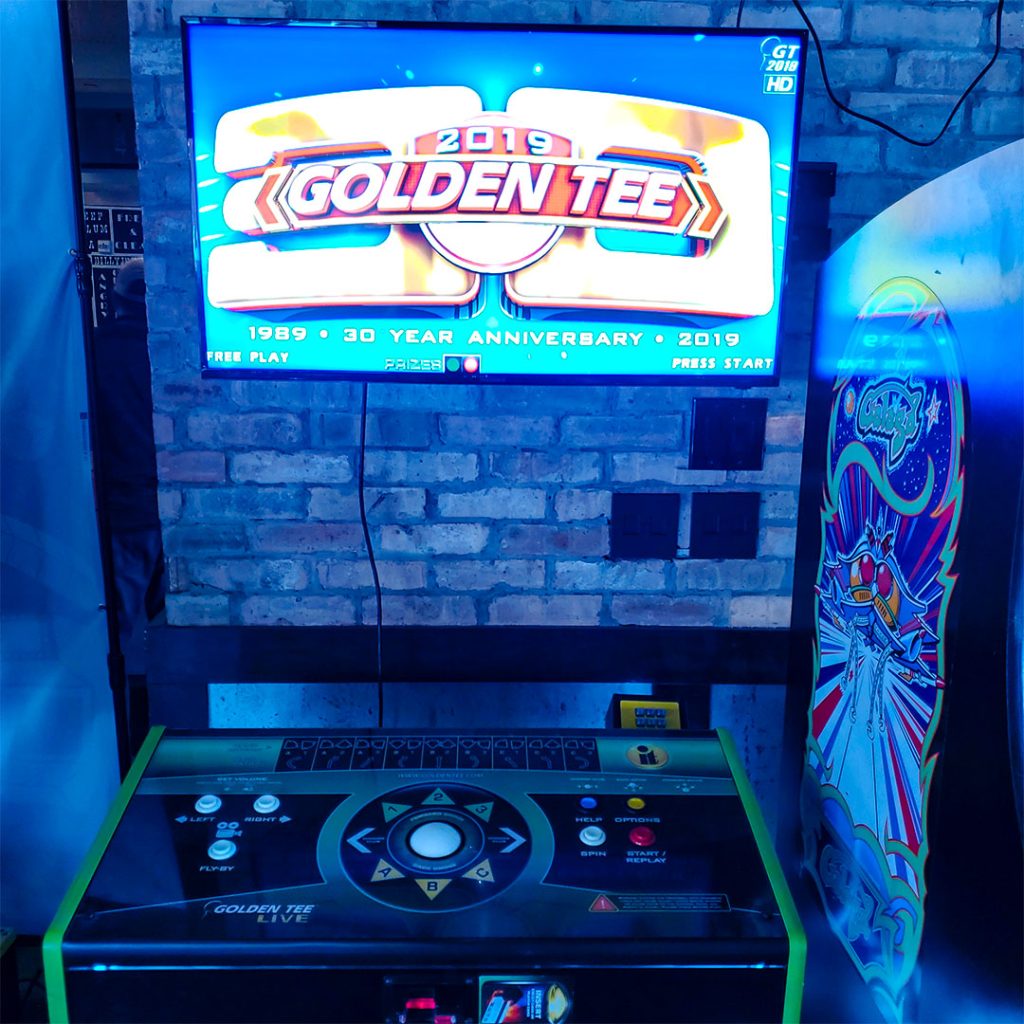
Released: 2009
Publisher: Raw Thrills
Developer: Activision / Konami
Guitar Hero is a series of music rhythm game video games first released in 2005, in which players use a guitar-shaped game controller to simulate playing primarily lead, bass guitar, and rhythm guitar across numerous songs. Players match notes that scroll on-screen to colored fret buttons on the controller, strumming the controller in time to the music in order to score points, and keep the virtual audience excited. The games attempt to mimic many features of playing a real guitar, including the use of fast-fingering hammer-ons and pull-offs and the use of the whammy bar to alter the pitch of notes.
Activision and Konami, who had previously worked together to make sure that the Guitar Hero series meets with Konami’s patents on music games, in conjunction with Raw Thrills, developed an arcade console version of the game, titled Guitar Hero Arcade, distributed to arcades in early 2009. The game is completely based on the Guitar Hero III gameplay, but reducing some of the features such as the use of the Whammy bar, Star Power Button (Star Power may only be activated by lifting the Guitar) and Practice Modes, but keeping the ability to download new songs for the cabinet from the Internet. The arcade game has come under some scrutiny by the American Society of Composers, Authors and Publishers (ASCAP), who believe the use of the game in arcades is equivalent to “public performances” and seek additional fees to be paid by operators of the game.
You can read more about the Guitar Hero series here.
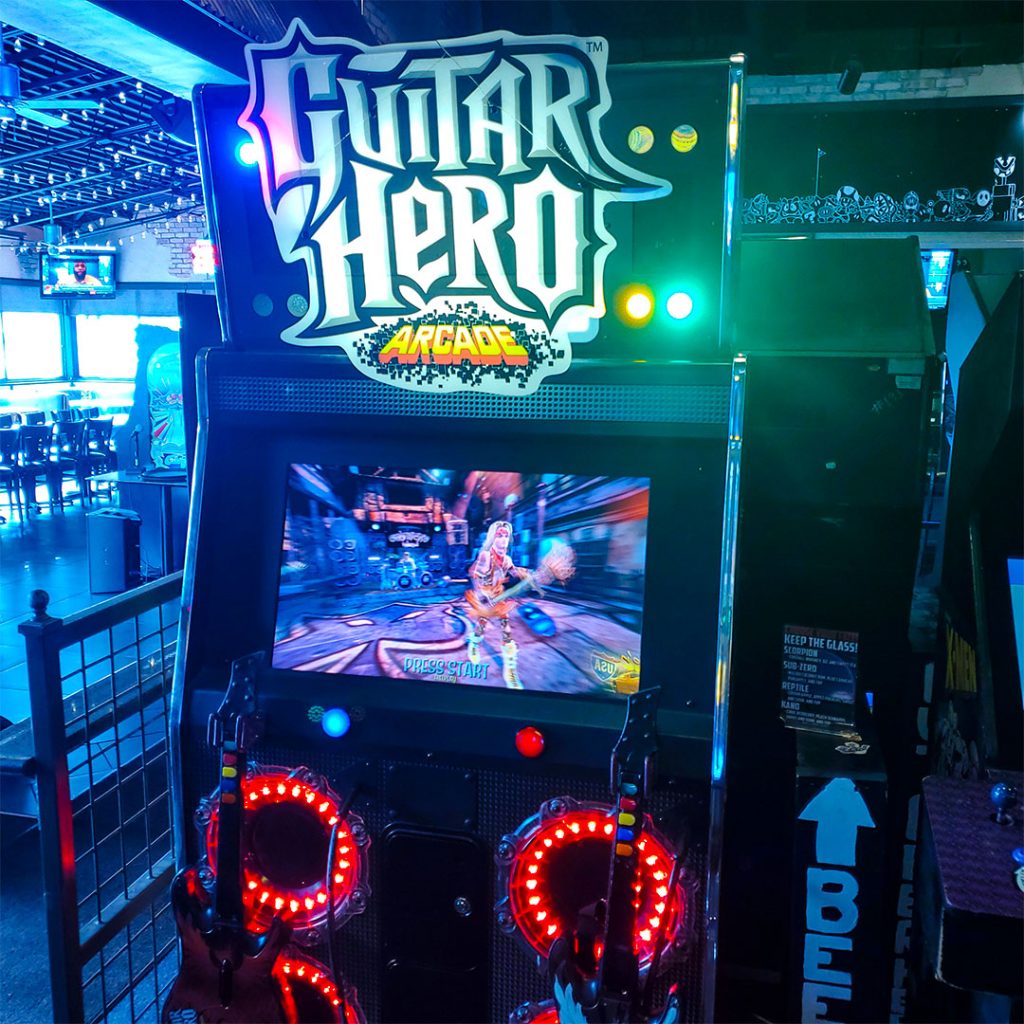
Released: 1996
Publisher: Sega
Developer: Sega AM1
The House of the Dead is a 1996 horror-themed light gun shooter arcade game developed by Sega AM1 and released by Sega. It is the first game in the House of the Dead series. Players assume the role of agents Thomas Rogan and “G” in their efforts to combat the products of the dangerous, inhumane experiments of Dr. Curien, a mad scientist.
The game was developed for over a year on the Sega Model 2 arcade hardware. Targeting an adult audience, AM1 devised a story and atmosphere inspired by Western horror films. AM1’s plans for detailed environments, non-linear level designs, and a gory aesthetic were challenged — and often limited — by the Model 2 hardware and other factors.
The House of the Dead is a rail shooter light gun game. Players use a light gun (or mouse, in the PC version) to aim and shoot at approaching zombies. The characters’ pistols use magazines which hold 6 rounds; players reload by shooting away from the screen. When a player sustains damage or shoots an innocent, one point of health is removed. The continue screen appears when all health is lost. If the player runs out of continues, the game is over. First-aid packs are available throughout the game which restore one point of health; some can be obtained from rescued hostages, while others are hidden inside certain breakable objects. Special items can be found within other breakables, granting a bonus to the player who shoots them. The player can earn additional health power-ups at the end of each level based on the number of hostages rescued.
Throughout the course of the game, players are faced with numerous situations in which their action (or inaction) will have an effect on the direction of gameplay. This is exemplified in the opening stage of the game when a hostage is about to be thrown from the bridge to his death. If the player saves the hostage, they will enter the house directly through the front door; however, if the player fails to rescue the hostage, the character is redirected to an underground route through the sewers. If the player rescues all hostages, a secret room full of lives and bonuses is revealed toward the end of the game.
Players can score additional points by shooting enemies in the head and by rescuing hostages.
You can read more about The House of The Dead here.
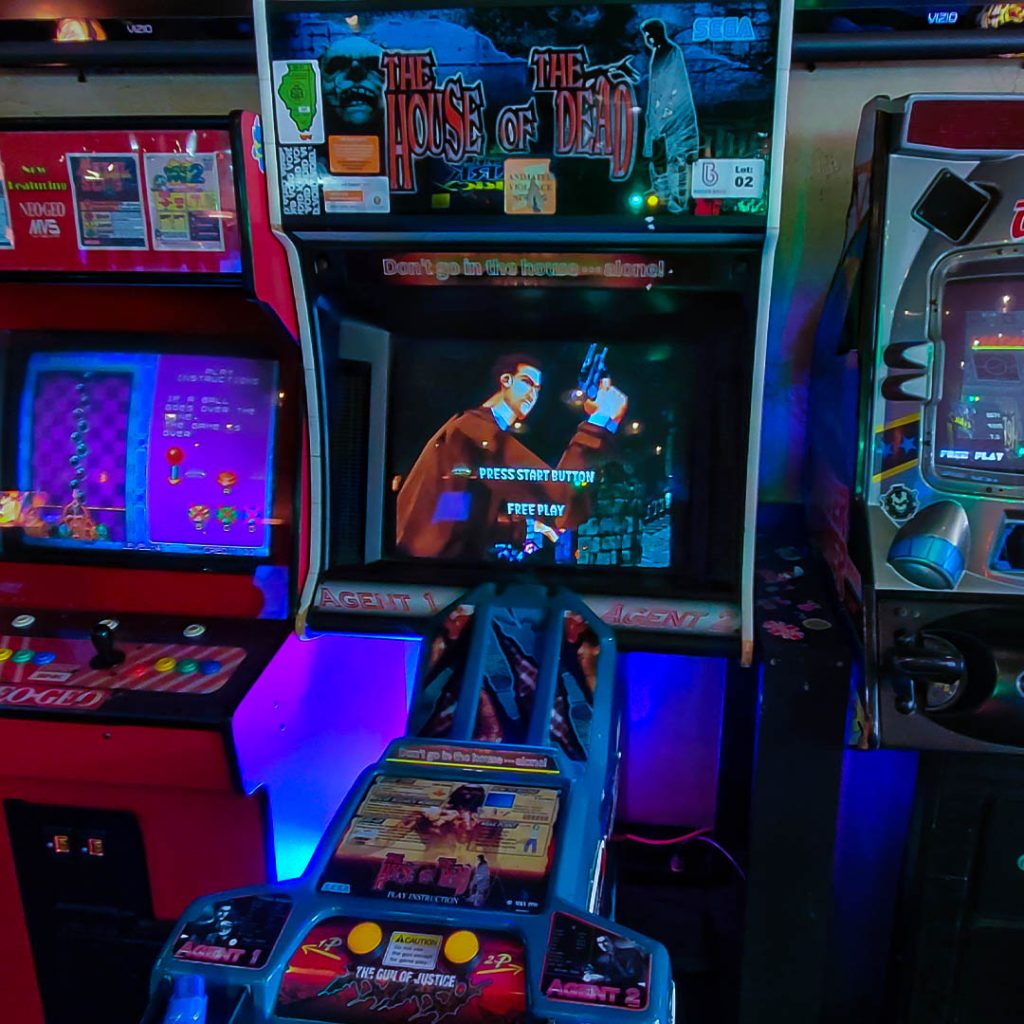
Released: 1996
Publisher: Midway
Developer: Rare
Killer Instinct 2 is a fighting video game developed by Rare and manufactured by Midway for arcades in 1996 as a sequel to Killer Instinct (1994).
As with most fighting games and indeed its predecessor, two characters square off with the goal of depleting the opponent’s life bar. As with the original Killer Instinct, when a character’s original life bar is fully depleted, he or she will fall to the ground, and immediately begin on his or her second lifebar.
As with the first game, Killer Instinct 2 relies on an automatic combo subsystem in its matches. The matches, as with Killer Instinct, revolve around a three strength system (Quick, Medium and Fierce). However, normal moves have lost a lot of their priority and range, as well as gaining extra recovery time. Throws have been added into the game to deal with blocking characters (as opposed to the top attack in Killer Instinct). Additionally, characters can be knocked down much easier with normal moves than in the first game, ending the possibility of opening with a ‘glitch’ combo and also weakening the effectiveness of normal moves. Normal special moves no longer are judged on priority, but instead follow a three tiered ‘rock, paper, scissors’ system, in which a certain special move will always break another certain special move (similar to the three tiered system in Soulcalibur).
Additionally, a Super bar has been added to the game (similar to Street Fighter Alpha or The King of Fighters series). This super bar fills as a fighter takes damage or executes an attack that is blocked by the opponent. After the bar reaches a certain point, the player can use a multi-hit Super Move which is usually an extended version of a normal special move.
You can read more about Killer Instinct 2 here.
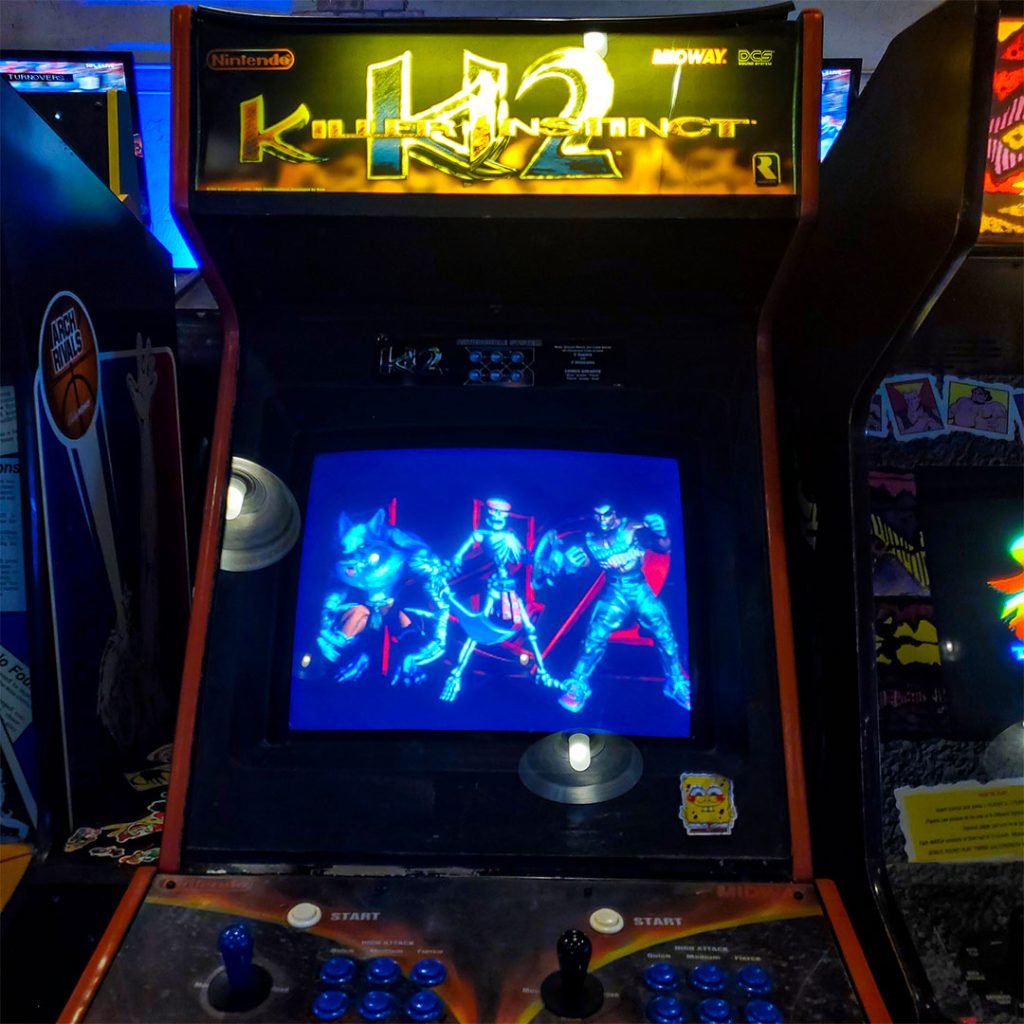
Released: 2013
Publisher: BumbleBear Games
Developer: BumbleBear Games
Killer Queen is a community-oriented, real-time strategy platform arcade video game for up to ten players. The game was developed by Josh DeBonis and Nikita Mikros, the co-founders of BumbleBear Games. It was initially developed as a field game, but premiered in its arcade form in 2013 at New York University’s fourth annual No Quarter exhibition for indie arcade games.
Killer Queen is a team-based, competitive game pitting ten players in teams of five against each other. The two teams, Blue and Gold, choose one player to be the Queen while other players start as Workers. The Queen is the most powerful unit in the game, and can lead teams to victory or defeat. All other players start off as a drone, a non-attacking unit that can pick up berries found in the arena and take them to Transformation Gates or the team’s hive. Drones can transform either into a Speed Drone, who can move around faster, or a Warrior, which loses the Drone’s abilities to instead wield a sword and kill the enemy’s Drones, Warriors or Queen.
Transformation Gates start off unclaimed, but can be turned to one team’s color by a Queen of that color. Several Gates are found throughout the different arenas, a drone transforms to either a Warrior or Speed Drone by bringing a berry to an activated Gate corresponding to that character. Drones are easy to kill, but respawn infinitely. If a Warrior is killed, the player respawns as a Drone and must get to another Warrior gate to gain Warrior powers again. Queens have three lives, represented by three eggs in their hive, and a team loses the game once the third hatched Queen has died.
Economic Victory is attained by filling a team’s honeycomb hive with berries. Drones carry one berry at a time to their hive while dodging opposing Warrior and Queen attacks. Snail Victory is achieved by riding the slow-moving Snail at the bottom of the arena to one side in a tug-of-war-like back and forth battle. Opposing teams can slow down the snail by killing its Drone rider, sacrificing a Drone of their own (who will be eaten by the Snail, slowing its pace) or riding the snail back toward their side of the map. Military Victory is achieved when the opposing team’s Queen is killed three times by attacks from either Warriors or Queen.
To successfully attack an enemy Warrior or Queen, players must strike it from above or behind. This gameplay element is reminiscent of the arcade game Joust and emphasizes positioning and quick, reactive strategy. If players strike each other from the front, while on the same level, they bounce back and no damage is done. The community of players inspired by this game has developed a long list of tactics and strategies for victory, lending to the competitiveness of the game.
You can read more about Killer Queen here.
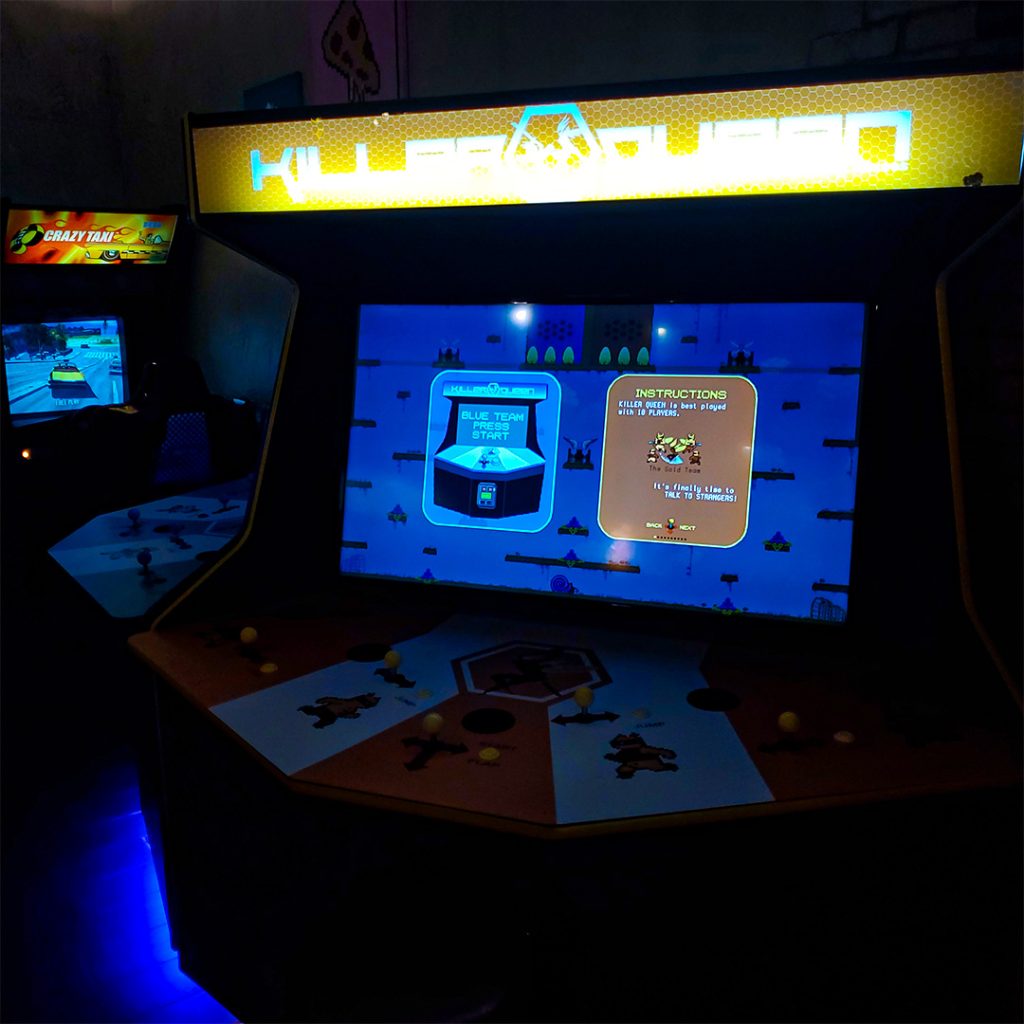
Released: 2006
Publisher: Sega
Developer: Sega
Let’s Go Jungle!: Lost on the Island of Spice is a joystick-mounted gun arcade game by Sega. The game was released on June 27, 2006. Players take the roles of Ben and Norah stranded on a jungle island which has been overrun by monsters. Each player must shoot the monsters with his or her machine guns while looking for rescue.
Let’s Go Jungle!: Lost on the Island of Spice is an on-rails arcade shooter. Players assume the roles of dysfunctional couple Ben and Norah, who are going on an island tour to work out their problems. Co-op is available as a mode of play, though one may play alone as well. Players must make their way across the island of Spice, while killing mutated animals and insects, such as frogs, leeches, spiders, water bugs, piranhas, pillbugs, fleas, and flies, along the way. The players are given FN FAL assault rifles early in the game to fend off the creatures, and this will be the primary weapon for use against the creatures. However, sometimes improvised weapons, such as paddles and slingshots, will have to be used. All weapons are controlled by a light gun controller on a mounted fulcrum, similar to another Sega on-rail shooter, The Ocean Hunter. The “Deluxe” Arcade Cabinet allows players to sit inside a model offroad truck.
Some parts of every level are quick-time events, where players must move the gun in a certain direction, rapidly tap a button or tap a button at the right time to survive a dangerous situation. Higher points are awarded for executing quick-time events sooner, where failure will cause the player’s life bar to decrease, although the bar will drop to 1% (and stay there) if the player missed a quick-time event with only a little bit of life remaining, as it is not possible for a game over to occur during any particular sequence of quick-time events.
At the end of each stage, the player must battle a boss, which is usually a heavily mutated and powerful monster. To attack it, the player must quickly shoot at each of several indicated target points that are marked on the boss until they disappear. Failure to hit all targets within a short period of time will allow the boss to attack the player and deal massive damage, while hitting all targets will deal damage to the boss and disrupt its attempted attack. Bosses are extremely powerful such that the player can only survive at most two attacks from a boss before having to continue.
Similar to The House of the Dead 4 Special, the games co-op gives a compatibility rating based on how well the two players work together. Enemies include various bugs, spiders, piranhas and frogs. The font style of the texts used throughout the game is based on the Thai alphabet.
You can read more about Let’s Go Jungle! here.
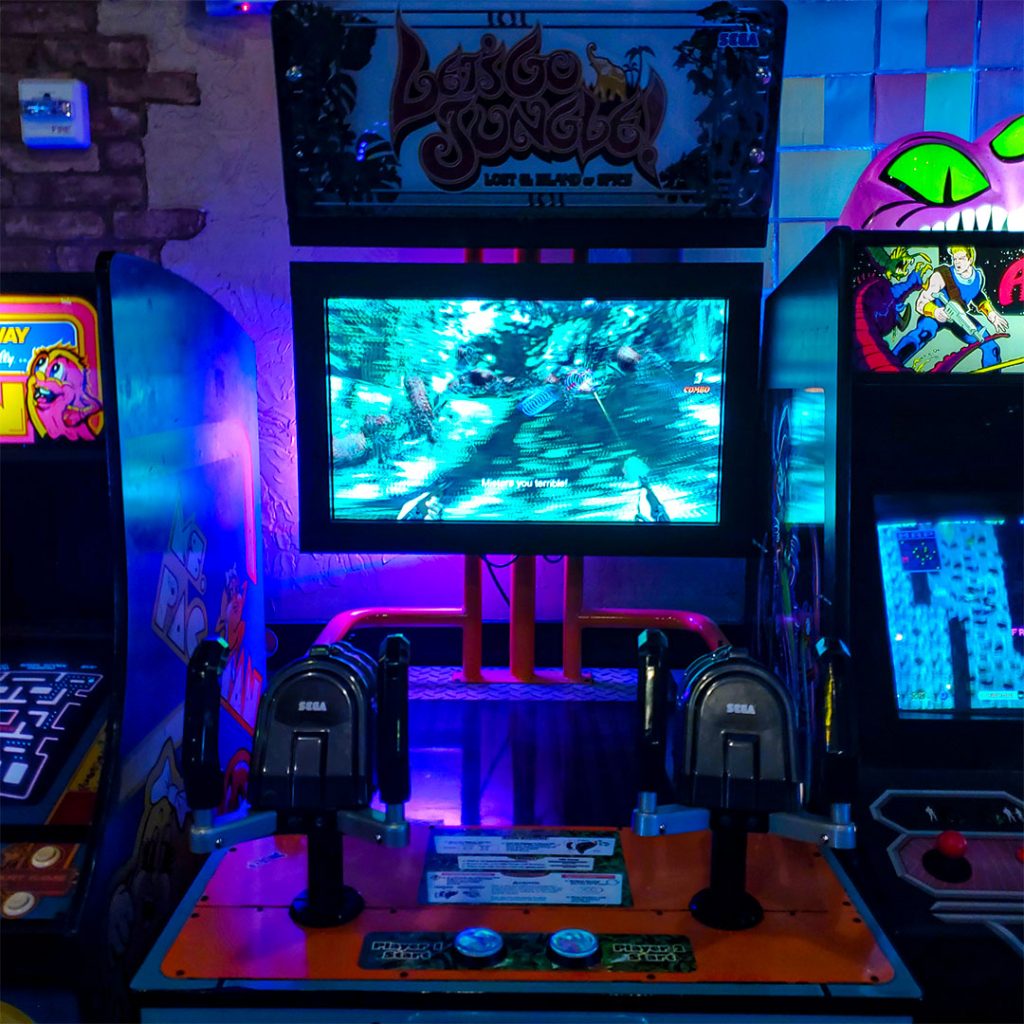
Released: 2000
Publisher: Capcom
Developer: Capcom
Marvel vs. Capcom 2: New Age of Heroes (Marvel vs. Capcom 2) is a crossover fighting game developed and published by Capcom. It is the fourth installment in the Marvel vs. Capcom series, which features characters from both Capcom’s video game franchises and comic book series published by Marvel Comics. Originally released in Japanese arcades in 2000, the game received ports to the Dreamcast, PlayStation 2, PlayStation 3, Xbox, Xbox 360, and iOS devices over the span of twelve years.
In Marvel vs. Capcom 2, players select a team of characters from the Marvel and Capcom universes to engage in combat and attempt to knock out their opponents. While the game uses similar tag team-based game mechanics to the series’ previous iteration, Marvel vs. Capcom: Clash of Super Heroes, it features several significant changes, such as three-on-three gameplay, a new character assist system, and a more simplified control scheme. The character artwork uses traditional 2D-animated sprites, while the backgrounds and visual effects are rendered in 3D. This makes Marvel vs. Capcom 2 the first game in the franchise to feature 2.5D graphics.
The game received positive reviews from critics, who praised its gameplay, visuals, and character roster, while criticizing its soundtrack and initial lack of online multiplayer support outside Japan. Since its release, it has been considered one of the best fighting games of all time as well as one of the greatest games of all time in general. Following its release, Capcom lost the use of the Marvel Comics license, putting the series on a decade-long hiatus. In April 2010, Capcom announced the development of a sequel, Marvel vs. Capcom 3: Fate of Two Worlds, which was later released in February 2011.
You can read more about Marvel vs. Capcom 2 here.
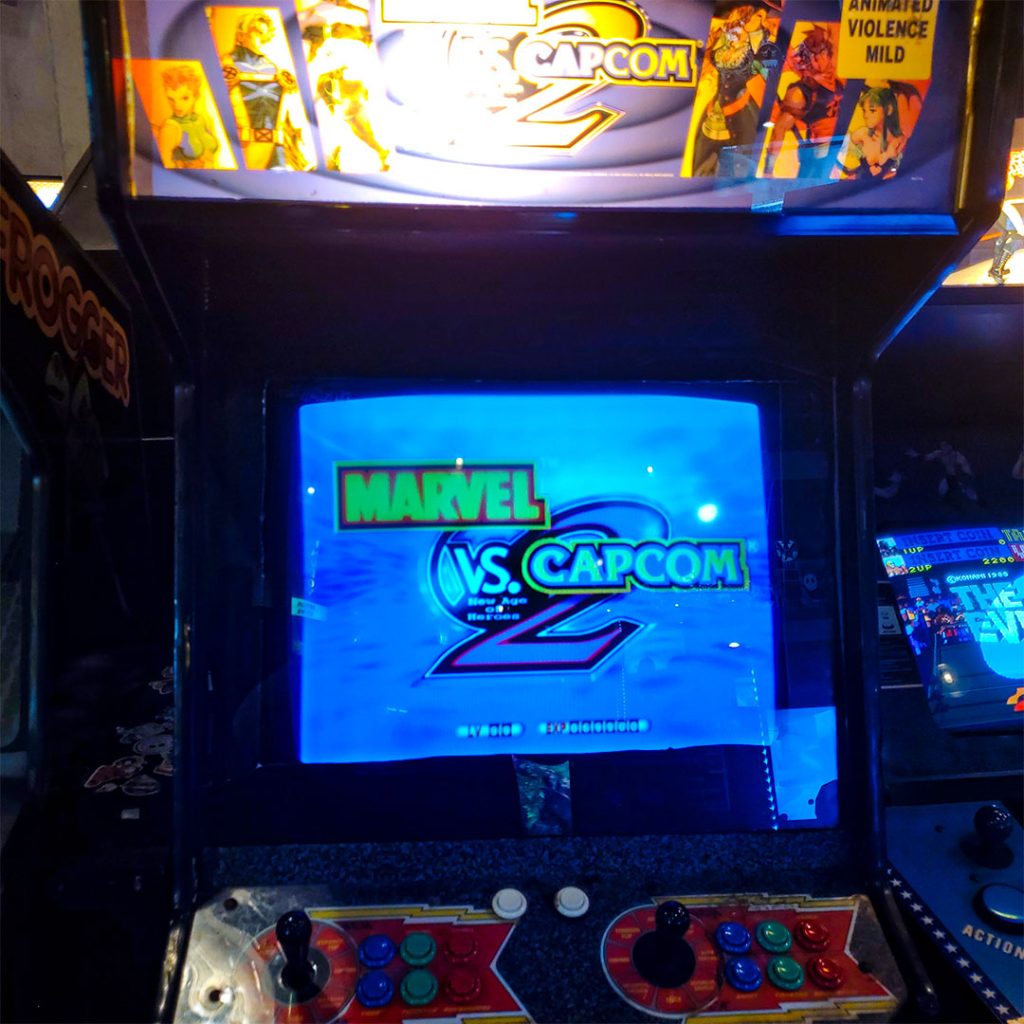
Released: 1993 – 1998
Publisher: Varies
Developer: Varies
The Neo Geo Multicade features four classic titles all on one machine!
– Metal Slug 2: Metal Slug 2 is a run and gun video game developed by SNK. It was originally released in 1998 for the Neo-Geo MVS arcade platform as the sequel to the 1996 game Metal Slug. The original version of the game had extensive slowdown and performance issues, eventually leading SNK to release a modified version in 1999 titled Metal Slug X: Super Vehicle-001 (メタルスラッグX). You can read more about Metal Slug 2 here.
– Puzzle Bobble 2: Puzzle Bobble 2 is a tile-matching video game by Taito. The first sequel to Puzzle Bobble, it is also known in Europe and North America as Bust-A-Move Again for arcades and Bust-A-Move 2 Arcade Edition for home consoles. Released into the arcades in 1995, home conversions followed for the PlayStation, Sega Saturn, Nintendo 64 and Windows platforms. You can read more about Puzzle Bobble 2 here.
– Super Sidekicks 2: Super Sidekicks 2: The World Championship is a 1994 soccer arcade video game developed and published by SNK. It is the second installment in the Super Sidekicks series and the third soccer game released for Neo Geo MVS, preceding the original Super Sidekicks (1992). Featuring an arcade-style approach to soccer as its predecessor, the game allows players to choose any of the available game modes with AI-controlled opponents or other human players with the team of their choosing. Its gameplay uses a simplified three-button configuration. You can read more about Super Sidekicks 2 here.
– World Heroes 2: World Heroes 2 is a 1993 fighting arcade game developed and published by ADK with the assistance of SNK. It was originally released for the Neo Geo MVS arcade cabinet on April 26, 1993. It is the sequel to the 1992 fighting arcade game World Heroes, as well as the second title of the World Heroes series. It was even the first game with the “ADK” logo labeled within the game after the developer changed from its previous name “Alpha Denshi”; however, the “Alpha” logo was last used on one of the arcade flyers of World Heroes 2. You can read more about World Heroes 2 here.
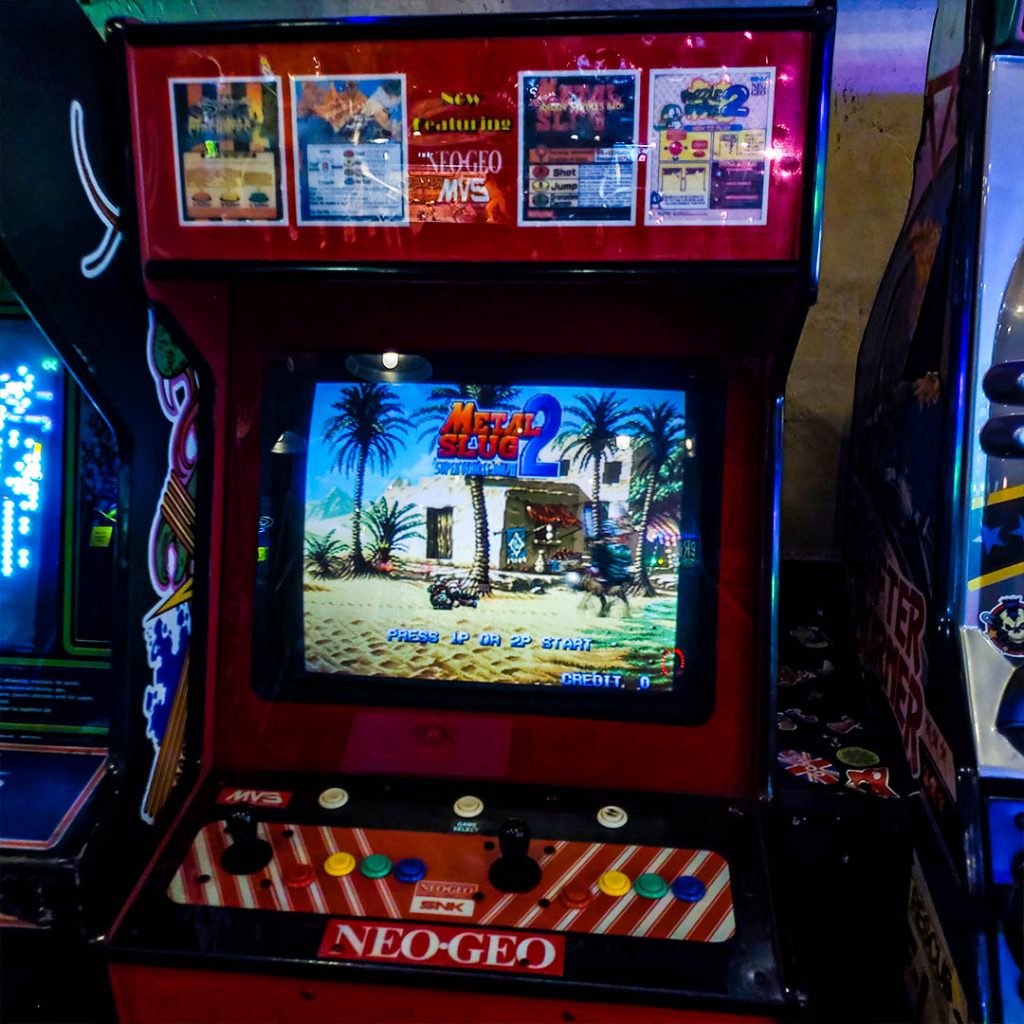
Released: 1985
Manufacturer: Nintendo
Developer: Nintendo R&D2
The Nintendo Entertainment System (NES) is an 8-bit third-generation home video game console produced by Nintendo. It was first released in Japan in 1983 as the Family Computer (FC), commonly known as the Famicom. The NES, a redesigned version, was released in American test markets on October 18, 1985, before becoming widely available in North America and other countries.
After developing a series of successful arcade games in the early 1980s, Nintendo planned to create a home video game console. Rejecting more complex proposals, the Nintendo president Hiroshi Yamauchi called for a simple, cheap console that ran games stored on cartridges. The controller design was reused from Nintendo’s portable Game & Watch games. Nintendo released several add-ons, such as a light gun for shooting games.
The NES was one of the best-selling consoles of its time and helped revitalize the US gaming industry following the video game crash of 1983. It introduced a now-standard business model of licensing third-party developers to produce and distribute games. The NES featured a number of groundbreaking games, such as the 1985 platform game Super Mario Bros. and the 1986 action-adventure games The Legend of Zelda and Metroid, which became long-running franchises. It was succeeded in 1990 by the Super Nintendo Entertainment System. In 2011, IGN named the NES the greatest video game console of all time.
You can read more about the Nintendo Entertainment System here.

Released: 2017
Manufacturer: Foxconn and Hosiden
Developer: Nintendo PTD
The Nintendo Switch is a hybrid video game console developed by Nintendo and released worldwide in most regions on March 3, 2017. The console itself is a tablet that can either be docked for use as a home console or used as a portable device, making it a hybrid console. Its wireless Joy-Con controllers, with standard buttons and directional analog sticks for user input, motion sensing, and tactile feedback, can attach to both sides of the console to support handheld-style play. They can also connect to a grip accessory to provide a traditional home console gamepad form, or be used individually in the hand like the Wii Remote and Nunchuk, supporting local multiplayer modes. The Nintendo Switch’s software supports online gaming through Internet connectivity, as well as local wireless ad hoc connectivity with other consoles. Nintendo Switch games and software are available on both physical flash-based ROM cartridges and digital distribution via Nintendo eShop; the system has no region lockout. A handheld-focused revision of the system, called the Nintendo Switch Lite, was released on September 20, 2019. A revised higher-end version of the original system, featuring an OLED screen, was released on October 8, 2021.
You can read more about the Nintendo Switch here.
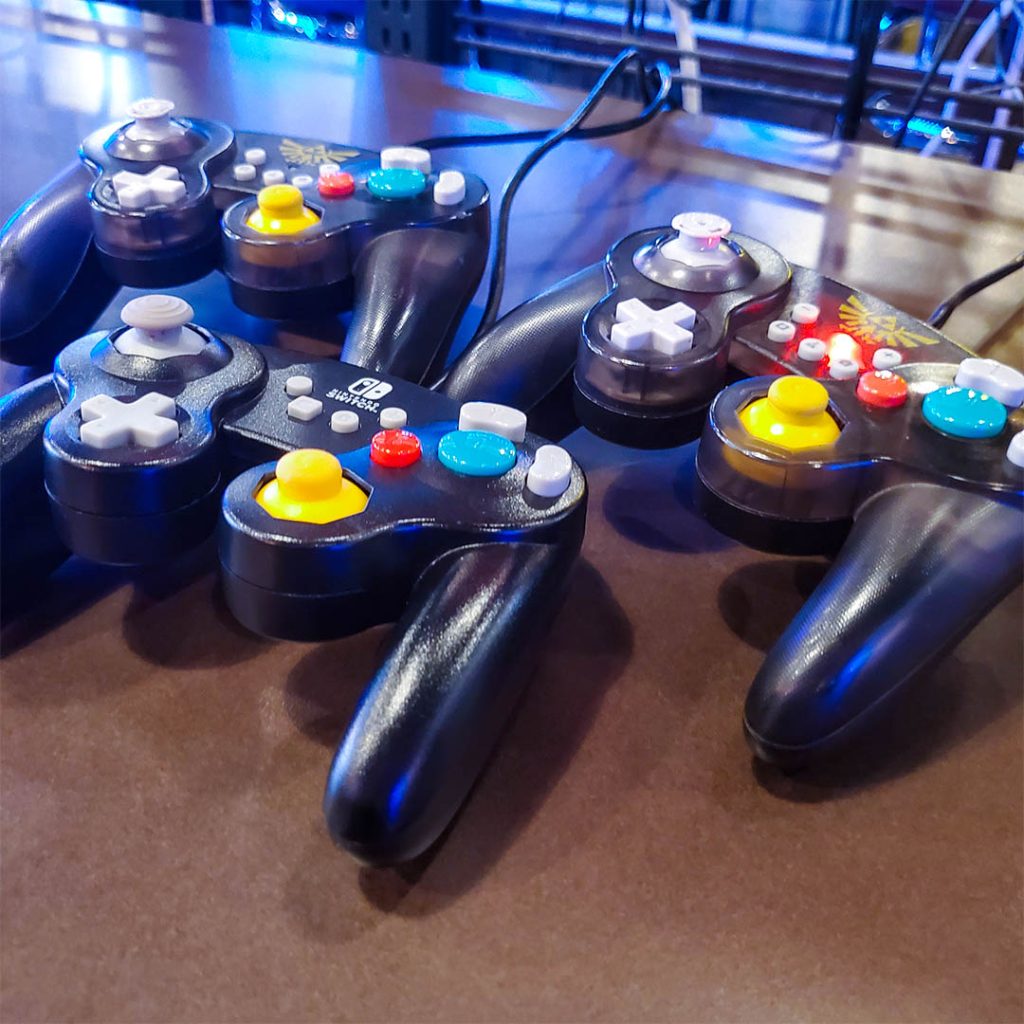
Released: 1999
Publisher: Midway Games
Developer: Midway Games
NFL Blitz 2000 is a video game released in the arcades in 1999 and then ported to the PlayStation, Nintendo 64, Dreamcast, Microsoft Windows, and Game Boy Color. It is the third game in the NFL Blitz series.
The Blitz titles largely follow standard American football rules as outlined by the NFL, but with key differences to encourage faster and more aggressive play. In the original games, seven players are on the field per side (as opposed to eleven). Not only were there fewer players, but positions were flexible at best. Wide receivers could be known to run the ball and sometimes pass, and defensive players were all crosses between pass rushers and defensive backs. 2002 saw an increase to eight players and NFL Blitz Pro (released in 2003) increased to the full eleven.
Unlike the NFL, pass interference is allowed, as are late hits, showboating and excessive celebrations. There are no timeouts, but the clock stops after every play. Extra point attempts are claimed to be automatic, but there are rare misses. Field goals and Two-point conversions are played out as usual. Quarters have been shortened to two minutes (default setting) with a faster running timer than real time; this includes overtime, which isn’t sudden death. For most releases, a first down would mean players would have to go 30 yards, instead of ten. Plays such as “Da Bomb” allowed for a quarterback to accurately throw the ball most of the length of the field at will and receivers could make impossible catches. On the other side, defensive players were able to leap up and swat (if not intercept) balls no other game could allow for or dive incredible lengths to make a stop.
You can read more about NFL Blitz 2000 here.
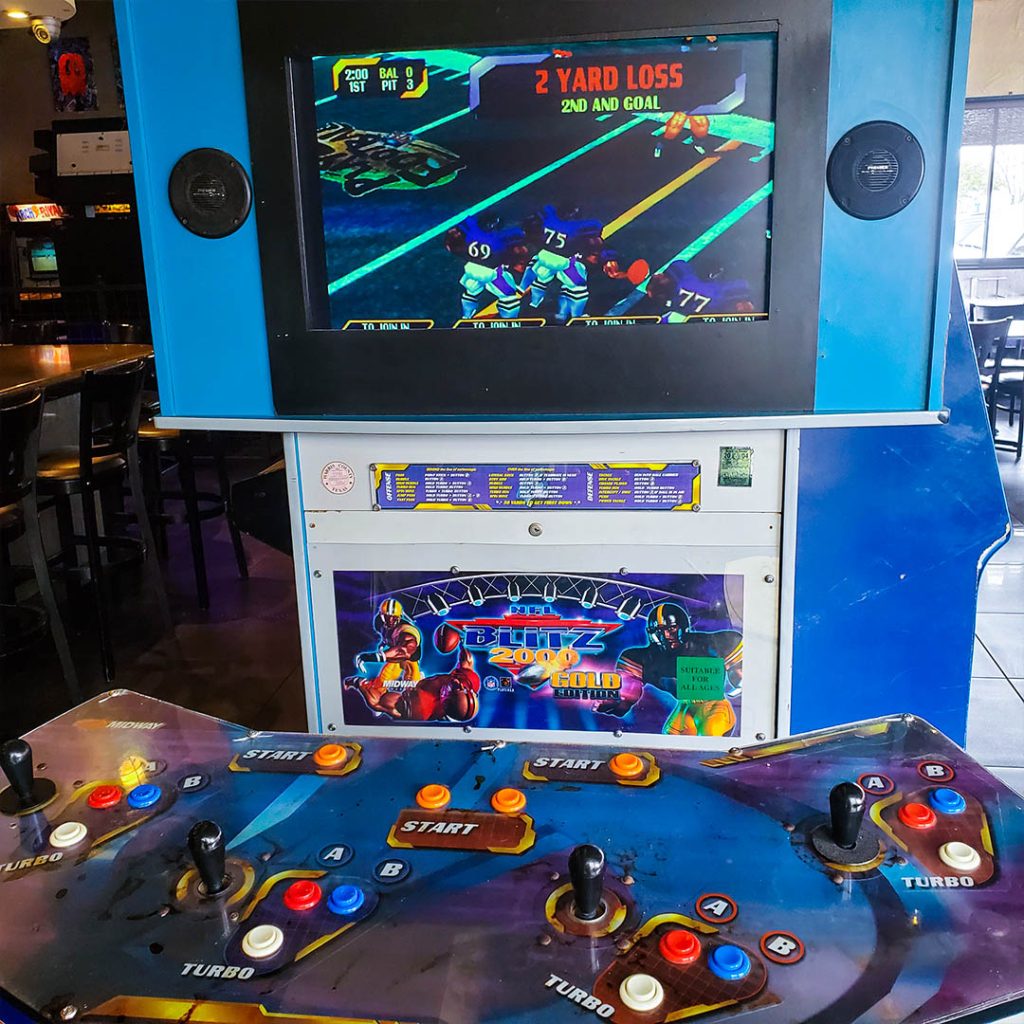
Released: 1980
Publisher: Namco/Midway
Developer: Namco
Pac-Man, originally called Puck Man in Japan, is a 1980 maze action video game developed and released by Namco for arcades. In North America, the game was released by Midway Manufacturing as part of its licensing agreement with Namco America. The player controls Pac-Man, who must eat all the dots inside an enclosed maze while avoiding four colored ghosts. Eating large flashing dots called “Power Pellets” causes the ghosts to temporarily turn blue, allowing Pac-Man to eat them for bonus points.
Game development began in early 1979, directed by Toru Iwatani with a nine-man team. Iwatani wanted to create a game that could appeal to women as well as men, because most video games of the time had themes of war or sports. Although the inspiration for the Pac-Man character was the image of a pizza with a slice removed, Iwatani has said he also rounded out the Japanese character for mouth, kuchi (Japanese: 口). The in-game characters were made to be cute and colorful to appeal to younger players. The original Japanese title of Puck Man was derived from the Japanese phrase “Paku paku taberu” which refers to gobbling something up; the title was changed for the North American release to mitigate vandalism.
Pac-Man is an action maze chase video game; the player controls the eponymous character through an enclosed maze. The objective of the game is to eat all of the dots placed in the maze while avoiding four colored ghosts — Blinky (red), Pinky (pink), Inky (cyan), and Clyde (orange) — that pursue Pac-Man. When Pac-Man eats all of the dots, the player advances to the next level. Levels are indicated by fruit icons at the bottom of the screen. In between levels are short cutscenes featuring Pac-Man and Blinky in humorous, comical situations.
If Pac-Man is caught by a ghost, he will lose a life; the game ends when all lives are lost. Each of the four ghosts has their own unique artificial intelligence (A.I.), or “personality”: Blinky gives direct chase to Pac-Man; Pinky and Inky try to position themselves in front of Pac-Man, usually by cornering him; and Clyde will switch between chasing Pac-Man and fleeing from him.
Placed at the four corners of the maze are large flashing “energizers” or “power pellets.” Eating these will cause the ghosts to turn blue with a dizzied expression and to reverse direction. Pac-Man can eat blue ghosts for bonus points; when a ghost is eaten, their eyes make their way back to the center box in the maze, where the ghost “regenerates” and resumes their normal activity. Eating multiple blue ghosts in succession increases their point value. After a certain amount of time, blue-colored ghosts will flash white before turning back into their normal form. Eating a certain number of dots in a level will cause a bonus item — usually in the form of a fruit — to appear underneath the center box; the item can be eaten for bonus points. To the sides of the maze are two “warp tunnels”, which allow Pac-Man and the ghosts to travel to the opposite side of the screen. Ghosts become slower when entering and exiting these tunnels.
The game increases in difficulty as the player progresses: the ghosts become faster, and the energizers’ effect decreases in duration, eventually disappearing entirely. Due to an integer overflow, the 256th level loads improperly, rendering it impossible to complete.
You can read more about Pac-Man here.
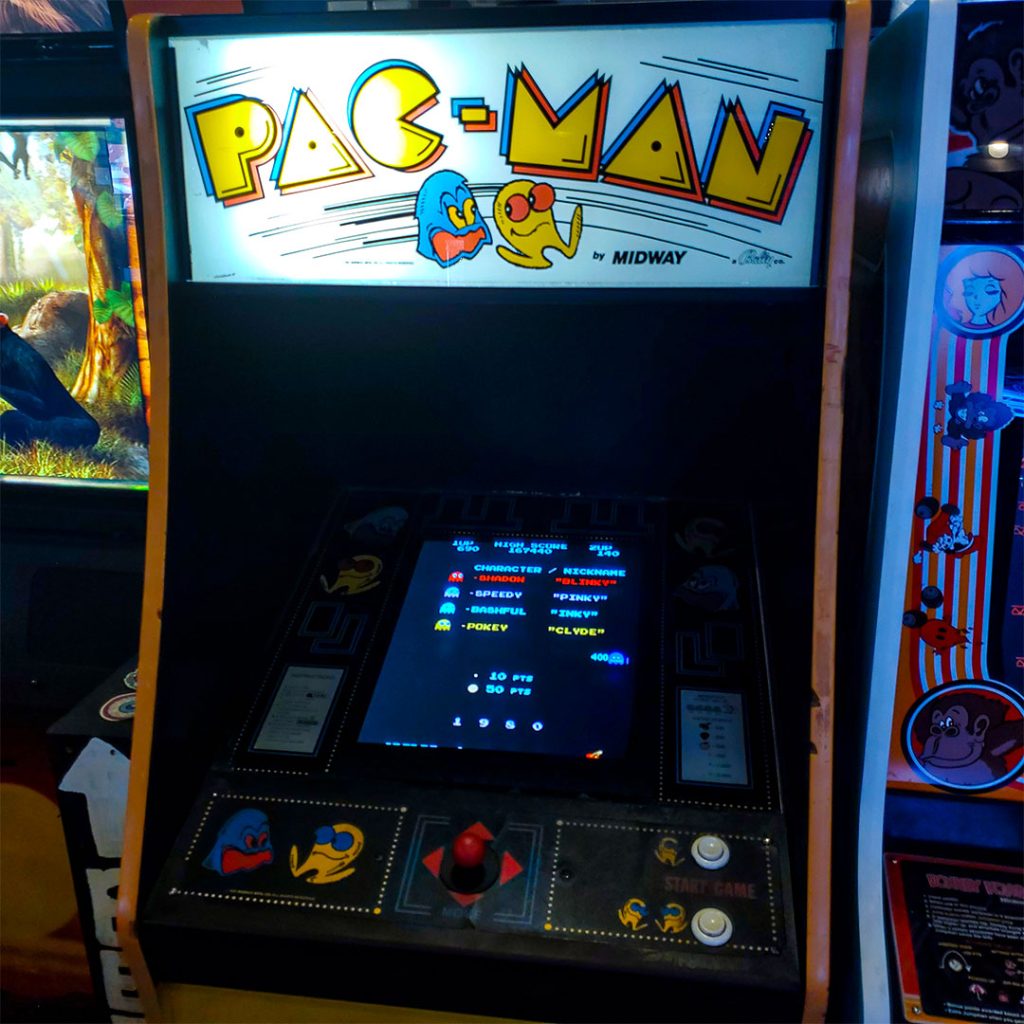
Released: 2020
Manufacturer: Sony / Foxconn
Developer: Sony Interactive Entertainment
The PlayStation 5 (PS5) is a home video game console developed by Sony Interactive Entertainment. It was announced as successor to the PlayStation 4 in April 2019, was launched on November 12, 2020, in Australia, Japan, New Zealand, North America, and South Korea, and was released worldwide one week later. The PS5 is part of the ninth generation of video game consoles, along with Microsoft’s Xbox Series X/S consoles, which were released in the same month.
The base model includes an optical disc drive compatible with Ultra HD Blu-ray discs. The Digital Edition lacks this drive, as a lower-cost model for buying games only through download. The two variants were launched simultaneously.
The PlayStation 5’s main hardware features include a solid-state drive customized for high-speed data streaming to enable significant improvements in storage performance, an AMD GPU capable of 4K resolution display at up to 120 frames per second, hardware-accelerated ray tracing for realistic lighting and reflections, and the Tempest Engine for hardware-accelerated 3D audio effects. Other features include the DualSense controller with haptic feedback, backward compatibility with the majority of PlayStation 4 and PlayStation VR games, and the PlayStation VR2 headset.
You can read more about the Playstation 5 here.
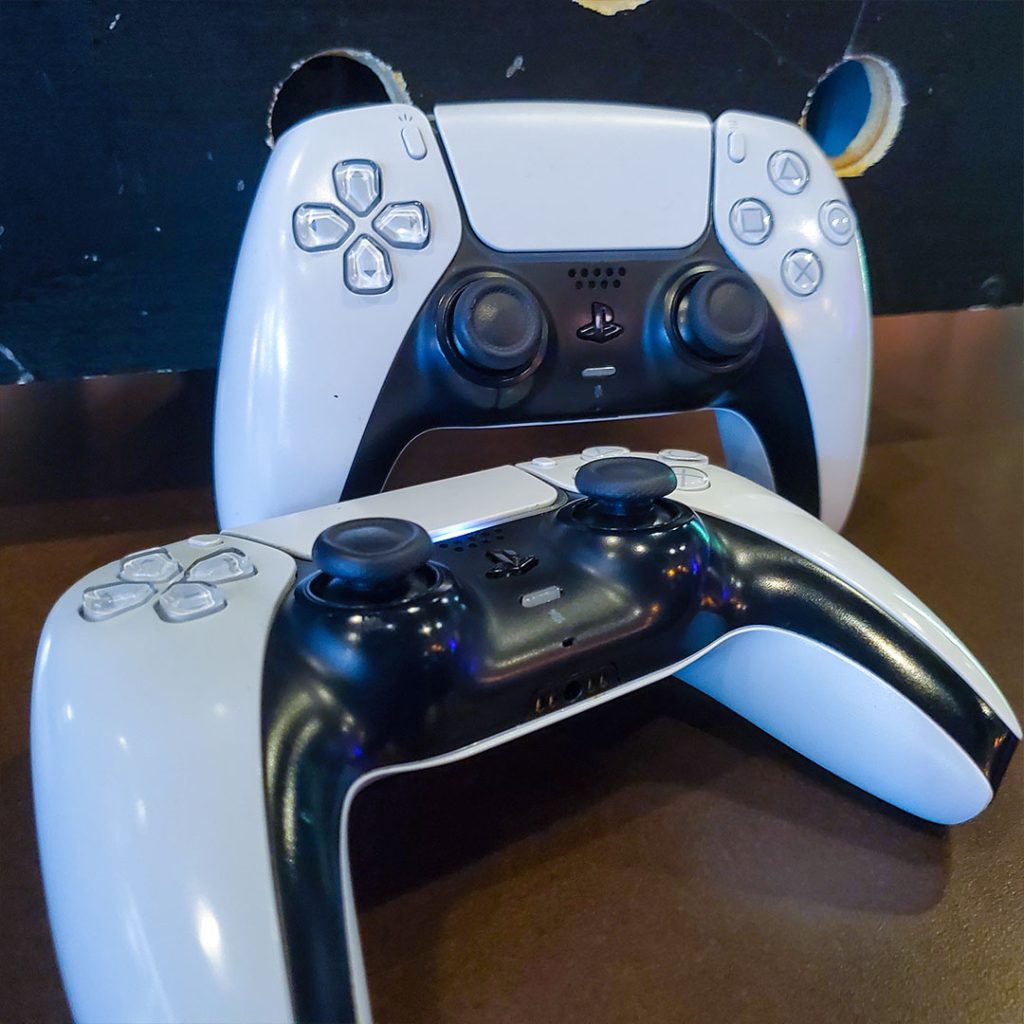
Released: 1994
Manufacturer: Sony Electronics
Developer: Sony Computer Entertainment
The PlayStation (abbreviated as PS, commonly known as the PS1/PS one or its codename PSX) is a home video game console developed and marketed by Sony Computer Entertainment. It was released in Japan on 3 December 1994, in North America on 9 September 1995, in Europe on 29 September 1995, and in Australia on 15 November 1995. As a fifth-generation console, the PlayStation primarily competed with the Nintendo 64 and the Sega Saturn.
Sony began developing the PlayStation after a failed venture with Nintendo to create a CD-ROM peripheral for the Super Nintendo Entertainment System in the early 1990s. The console was primarily designed by Ken Kutaragi and Sony Computer Entertainment in Japan, while additional development was outsourced in the United Kingdom. An emphasis on 3D polygon graphics was placed at the forefront of the console’s design. PlayStation game production was designed to be streamlined and inclusive, enticing the support of many third-party developers.
The console proved popular for its extensive game library, popular franchises, low retail price, and aggressive youth marketing which advertised it as the preferable console for adolescents and adults. Premier PlayStation franchises included Gran Turismo, Crash Bandicoot, Spyro, Tomb Raider, Metal Gear, Tekken, and Final Fantasy, all of which spawned numerous sequels. PlayStation games continued to sell until Sony ceased production of the PlayStation and its games on 23 March 2006—over eleven years after it had been released, and less than a year before the debut of the PlayStation 3. A total of 3,061 PlayStation games were released, with cumulative sales of 967 million units.
You can read more about the Playstation here.
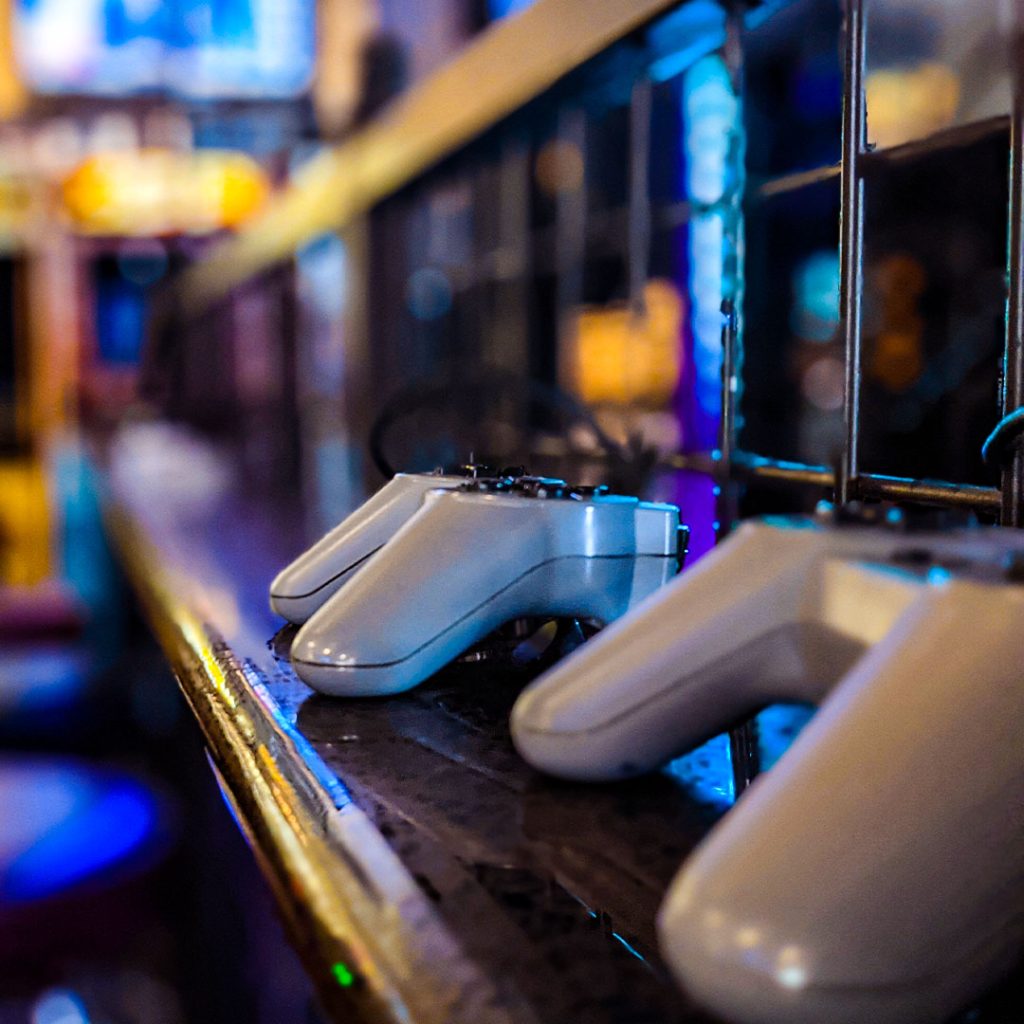
Released: 1982
Publisher: Gottlieb
Developer: Gottlieb
Q*bert (also known as Qbert) /ˈkjuːbərt/ is an arcade video game developed and published for the North American market by Gottlieb in 1982. It is a 2D action game with puzzle elements that uses isometric graphics to create a pseudo-3D effect. The objective of each level in the game is to change every cube in a pyramid to a target color by making Q*bert, the on-screen character, hop on top of the cube while avoiding obstacles and enemies. Players use a joystick to control the character.
The game was conceived by Warren Davis and Jeff Lee. Lee designed the title character and original concept, which was further developed and implemented by Davis. Q*bert was developed under the project name Cubes.
At the beginning, jumping on every cube once is enough to advance. In later stages, each cube must be hit twice to reach the target color. Other times, cubes change color every time Q*bert lands on them, instead of remaining on the target color once they reach it. Both elements are then combined in subsequent stages. Jumping off the pyramid results in the character’s death.
The player is impeded by several enemies, introduced gradually to the game:
You can read more about Q*Bert here.
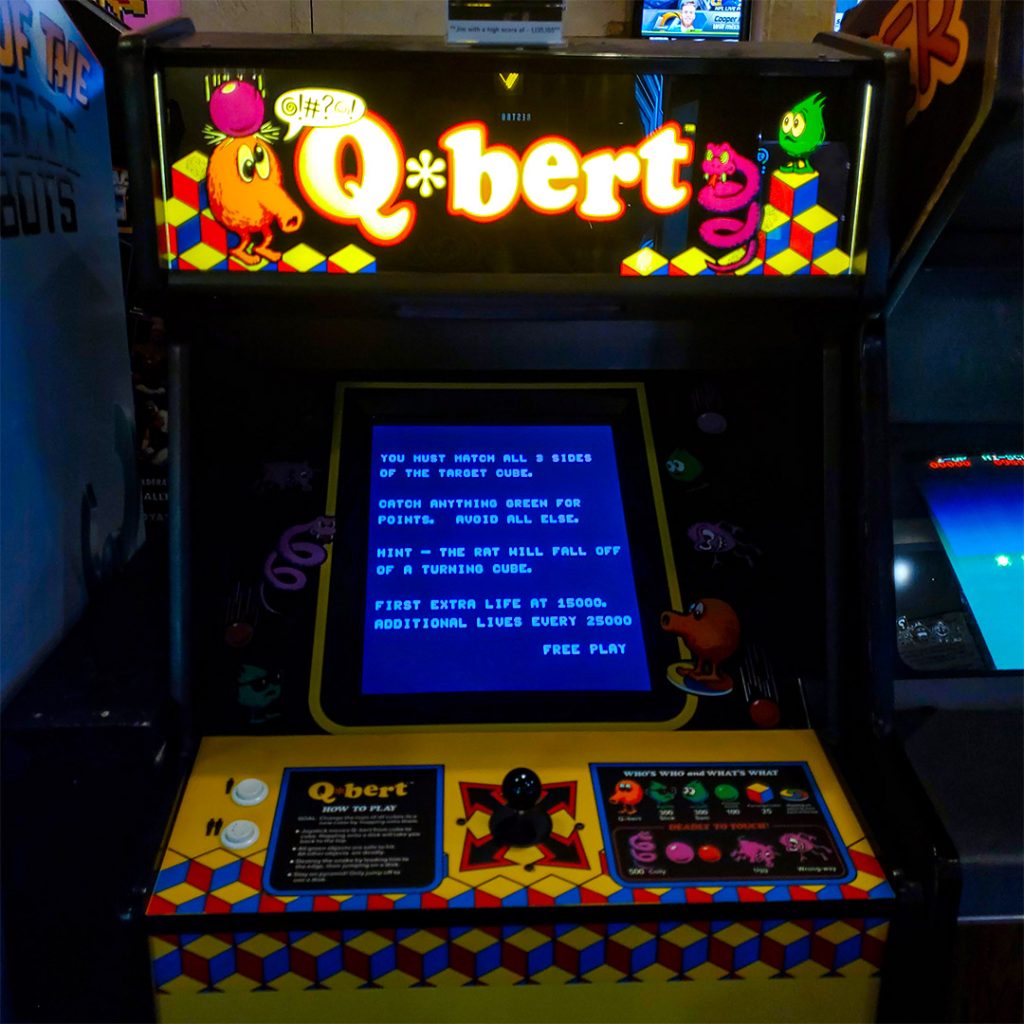
Released: 1994
Manufacturer: Sony Electronics
Developer: Sony Computer Entertainment
The Sega Genesis, known as the Mega Drive outside North America, is a 16-bit fourth generation home video game console developed and sold by Sega. It was Sega’s third console and the successor to the Master System. Sega released it in 1988 in Japan as the Mega Drive, and in 1989 in North America as the Genesis. In 1990, it was distributed as the Mega Drive by Virgin Mastertronic in Europe, Ozisoft in Australasia, and Tec Toy in Brazil. In South Korea, it was distributed by Samsung as the Super Gam*Boy and later the Super Aladdin Boy.
Designed by an R&D team supervised by Hideki Sato and Masami Ishikawa, the Genesis was adapted from Sega’s System 16 arcade board, centered on a Motorola 68000 processor as the CPU, a Zilog Z80 as a sound controller, and a video system supporting hardware sprites, tiles, and scrolling. It plays a library of more than 900 games on ROM-based cartridges. Several add-ons were released, including a Power Base Converter to play Master System games. It was released in several different versions, some created by third parties. Sega created two network services to support the Genesis: Sega Meganet and Sega Channel.
In Japan, the Mega Drive fared poorly against its two main competitors, Nintendo’s Super Famicom and NEC’s PC Engine, but it achieved considerable success in North America, Brazil, and Europe. Contributing to its success was its library of arcade game ports, the popularity of Sega’s Sonic the Hedgehog series, several popular sports franchises, and aggressive youth marketing that positioned it as the cool console for adolescents. The 1991 North American release of the Super Nintendo Entertainment System triggered a fierce battle for market share in the United States and Europe known as the “console war”. This drew attention to the video game industry, and the Genesis and several of its games attracted legal scrutiny on matters involving reverse engineering and video game violence. Controversy surrounding violent games such as Night Trap and Mortal Kombat led Sega to create the Videogame Rating Council, a predecessor to the Entertainment Software Rating Board.
You can read more about the Sega Genesis here.
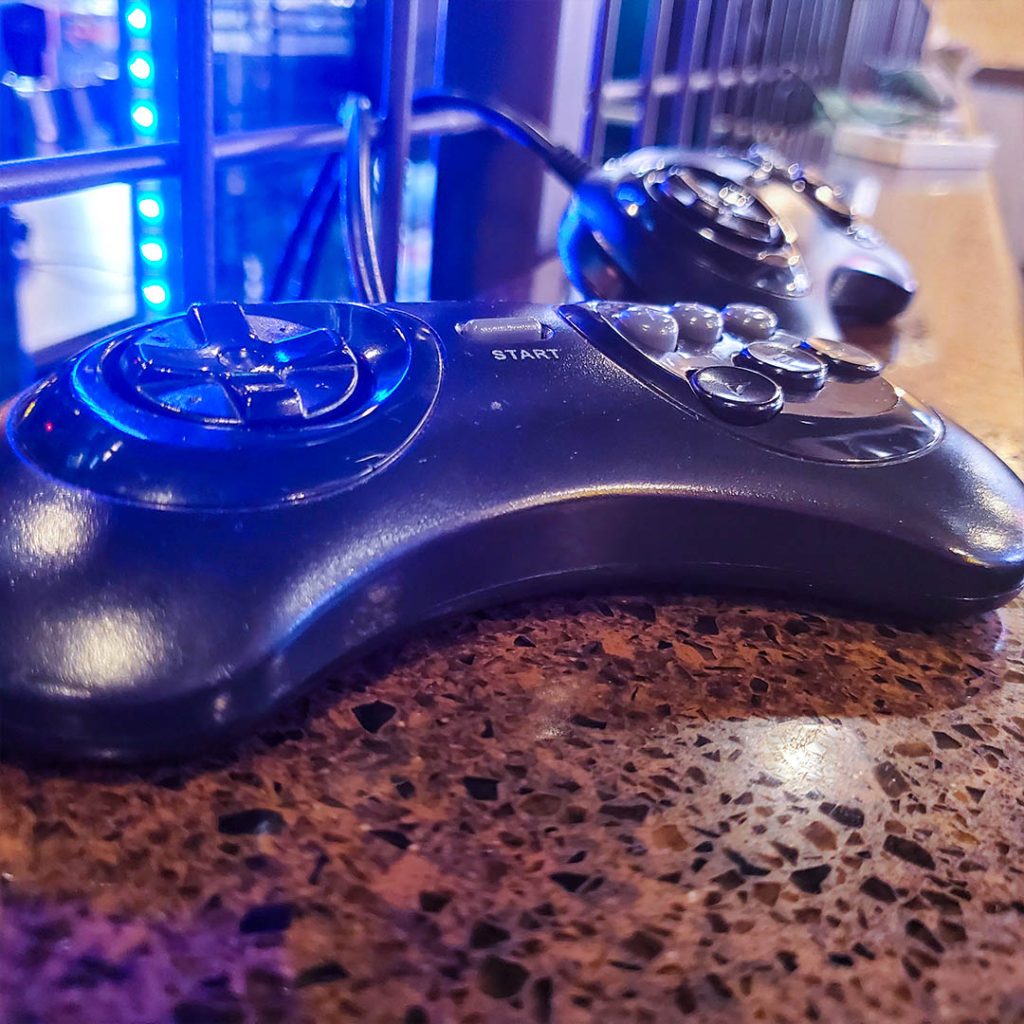
Released: 1990
Manufacturer: Nintendo
Developer: Nintendo R&D2
The Super Nintendo Entertainment System (SNES), commonly shortened to Super NES or Super Nintendo, is a 16-bit home video game console developed by Nintendo that was released in 1990 in Japan and South Korea, 1991 in North America, 1992 in Europe and Oceania, and 1993 in South America. In Japan, it is called the Super Famicom (SFC). In South Korea, it is called the Super Comboy and was distributed by Hyundai Electronics. The system was released in Brazil on August 30, 1993, by Playtronic. Although each version is essentially the same, several forms of regional lockout prevent cartridges for one version from being used in other versions.
The Super NES is Nintendo’s second programmable home console, following the Nintendo Entertainment System (NES). The console introduced advanced graphics and sound capabilities compared with other systems at the time. It was designed to accommodate the ongoing development of a variety of enhancement chips integrated into game cartridges to be competitive into the next generation.
The Super NES received largely positive reviews and was a global success, becoming the best-selling console of the 16-bit era after launching relatively late and facing intense competition from Sega’s Genesis console in North America and Europe. Overlapping the NES’s 61.9 million unit sales, the Super NES remained popular well into the 32-bit era, with 49.1 million units sold worldwide by the time it was discontinued in 2003. It continues to be popular among collectors and retro gamers, with new homebrew games and Nintendo’s emulated rereleases, such as on the Virtual Console, the Super NES Classic Edition, Nintendo Switch Online; as well as several non-console emulators which operate on a desktop computer, such as Snes9x.
You can read more about the SNES here.

Released: 2012
Publisher: Konami
Developer: Konami
Sound Voltex (Japanese: サウンド ボルテックス, stylized as SOUND VOLTEX, often shortened as SDVX) is a series of music games by Konami. Sound Voltex Booth was tested on various cities in Japan starting on August 26, 2011 until September 19, 2011. It was then released on January 18, 2012.
Sequels Sound Voltex II: Infinite Infection, Sound Voltex III: Gravity Wars, Sound Voltex IV: Heavenly Haven, Sound Voltex: Vivid Wave, and Sound Voltex: Exceed Gear were released on June 5, 2013, November 20, 2014, December 21, 2016, February 28, 2019, and February 17, 2021 respectively. On February 17, 2021, the publisher Konami released a new version of the cabinet called Sound Voltex: Valkyrie Model which included new features, such as a touchscreen mainly used to adjust settings; the new cabinet doesn’t change the core gameplay. Sound Voltex has seen a limited release in arcades outside of Japan. An official North American release of Exceed Gear, along with the Valkyrie Model cabinet, released on June 30, 2022. A conversion of Sound Voltex III: Gravity Wars, with the subtitle Konami Game Station was released as a PC game on October 4, 2017. At late 2021, Sound Voltex (PC) is updated to Exceed Gear.
Various objects, otherwise known as notes, come towards the player on the course lane, which consists of 6 columns with rails. The player is required to input corresponding commands when the object reaches the Critical Line at the bottom of the screen. The command required will differ, depending on the objects. Four white buttons in the middle of the controller are used to hit the white notes. Two additional types of input are also required: two black buttons beneath the main four buttons, and two knobs on the top right and left corners. The black buttons (known as FX buttons) are used to hit the orange notes (FX notes). These not only add an extra layer of difficulty, but also add effects to the song, similar to that of a DJ mixed song. The knobs are used to control blue and pink lasers on the screen; the player simply turns the knobs in the direction of the corresponding laser. The left knob controls a blue laser, and the right knob controls a pink laser. A blue button on the top of the controller acts as the “Start” button, also being used as an “Okay” button of sorts. On the arcade cabinet, holding the start button whilst turning the right knob will change the lane speed. Lane speed is the speed of which the notes go down. (this is as of Exceed Gear, older versions may require a different command.)
You can read more about Sound Voltex here.
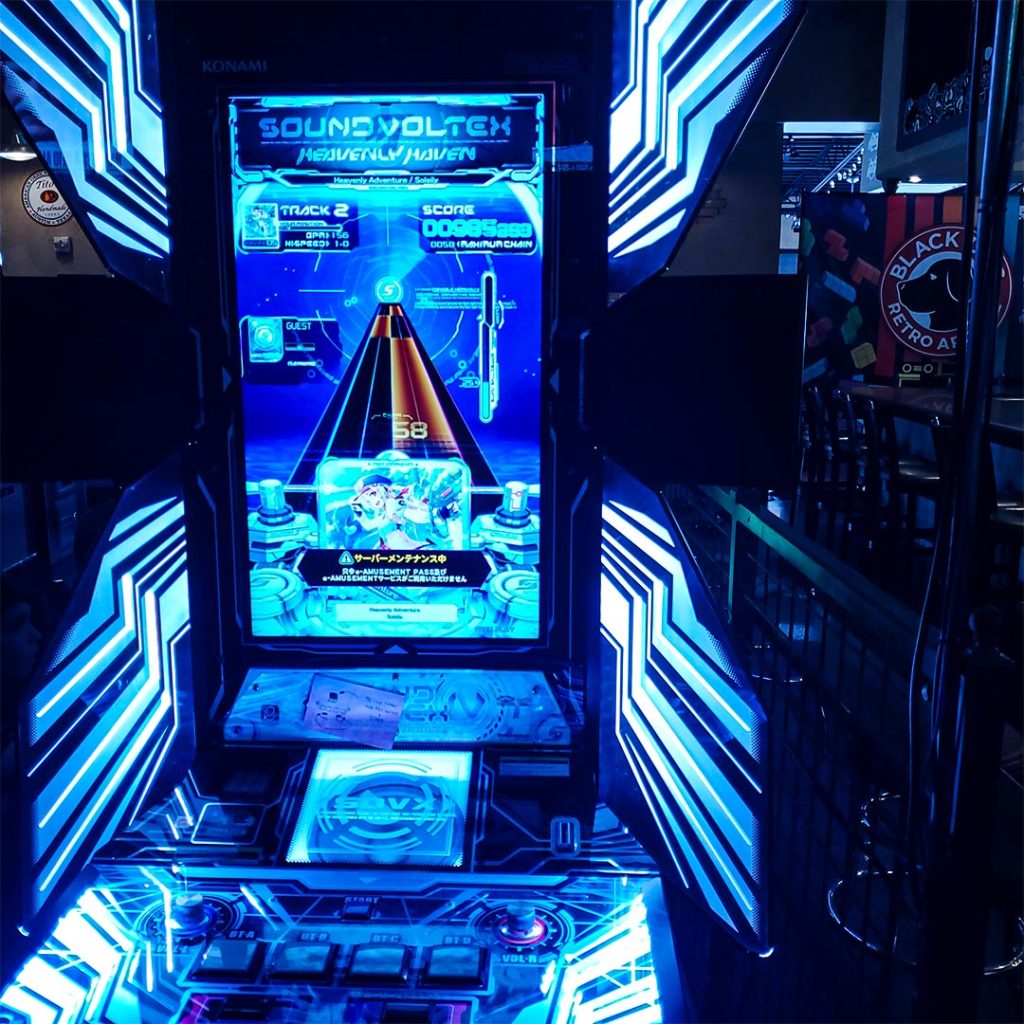
Released: 1991
Manufacturer: Capcom
Developer: Capcom
Street Fighter II: The World Warrior is a fighting game developed by Capcom and originally released for arcades in 1991. It is the second installment in the Street Fighter series and the sequel to 1987’s Street Fighter. It is Capcom’s fourteenth game to use the CP System arcade system board. Street Fighter II improved many of the concepts introduced in the first game, including the use of special command-based moves, a combo system, a six-button configuration, and a wider selection of playable characters, each with a unique fighting style.
It prominently features a popular two-player mode that obligates direct, human-to-human competitive play which prolonged the survival of the declining video game arcade business market by stimulating business and driving the fighter genre. It inspired grassroots tournament events, culminating into Evolution Championship Series (EVO). Street Fighter II shifted the arcade competitive dynamic from achieving personal-best high scores to head-to-head competition, including large groups.
Street Fighter II follows several conventions and rules established by its 1987 predecessor Street Fighter. The player engages opponents in one-on-one close quarter combat in a series of best-two-out-of-three matches. The objective of each round is to deplete the opponent’s vitality before the timer runs out. Both fighters having equal vitality left yields a “double KO” or “draw game” and additional rounds ensue until sudden death.
In the first Street Fighter II, a match can last up to ten rounds; this was reduced to four rounds since Champion Edition. If there is no clear winner by the end of the final round, either the computer-controlled opponent will win by default in a single-player match or both fighters will lose in a 2-player match. After every third match in the single-player mode, a bonus stage gives additional points including a car-breaking stage, a barrel breaking stage, and a drum-breaking stage. Between the matches, the next match location is selected on a world map.
Like in Street Fighter, the controls are an eight-directional joystick and six attack buttons. The joystick can jump, crouch, walk left and right, and block. A tradeoff of strength and speed are given by three punch buttons and three kick buttons, each of light, medium, and heavy. The player can perform a variety of basic moves in any position, including new grabbing and throwing attacks. Special moves are performed by combinations of directional and button-based commands.
Street Fighter II differs from its predecessor due to the selection of multiple playable characters, each with distinct fighting styles and special moves including combos. According to IGN, “the concept of combinations, linked attacks that can’t be blocked when they’re timed correctly, came about more or less by accident. Street Fighter II‘s designers didn’t quite mean for it to happen, but players of the original game eventually found out that certain moves naturally flowed into other ones.” This combo system was later adopted as a standard feature of fighting games and was expanded upon in this series.
You can read more about Street Fighter II here.
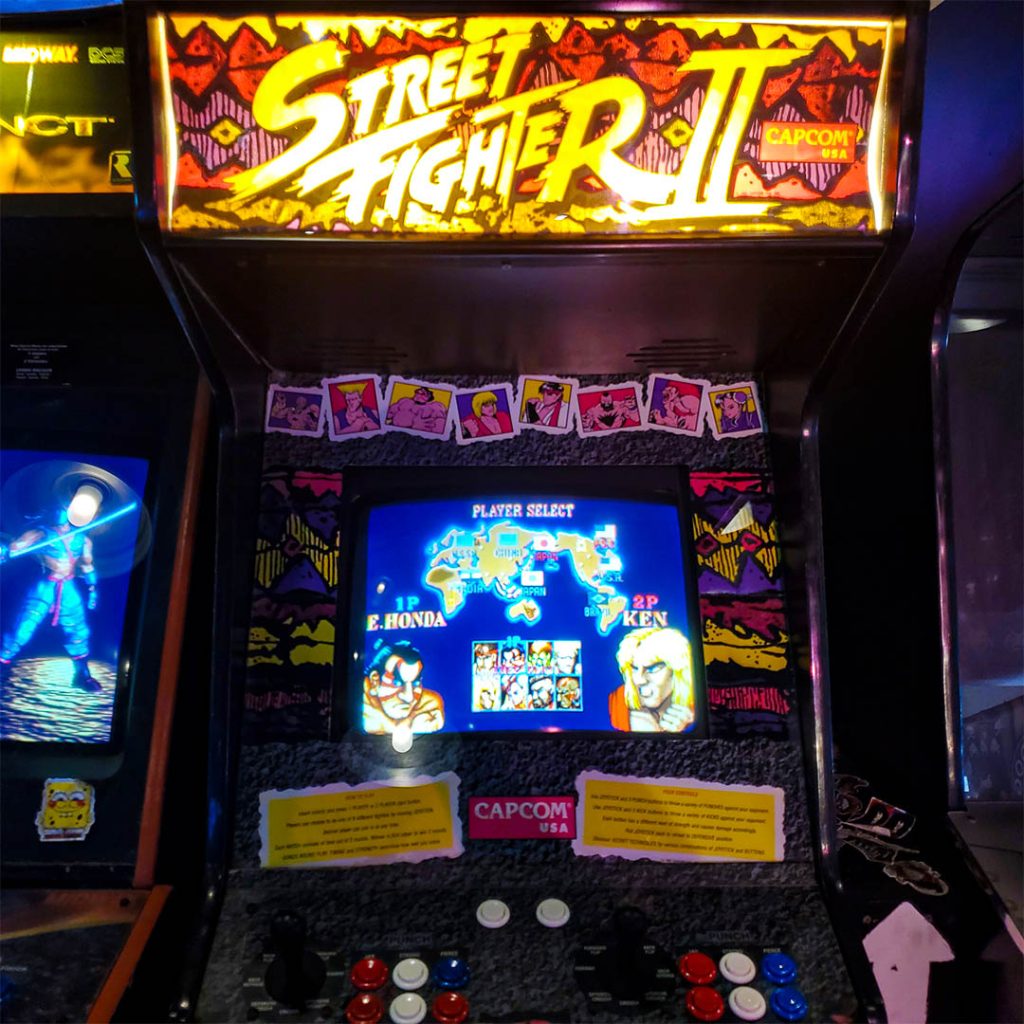
Released: 1997
Publisher: Psikyo
Developer: Psikyo
Strikers 1945 II (ストライカーズ1945II) is a vertically-scrolling shoot ’em up game developed and originally published by Psikyo in 1997 for the arcades as a follow-up to Strikers 1945. This game was also ported by Kuusou Kagaku to the PlayStation and Sega Saturn for Psikyo and re-released by Success in 2000. Agetec released Strikers 1945 II for the PlayStation in North America under the title Strikers 1945 in 2001, and Midas Games released it in Europe as a budget title in 2003. The game was also included in Psikyo Shooting Collection Vol. 1: Strikers 1945 I&II by Taito for PlayStation 2, later was released as a downloadable title for PlayStation Network by GungHo Online Entertainment, and finally for Android and iOS by Mobirix (as STRIKERS 1945-2). Also, after S&C Entertainment developed another version, they released it on Google Play, with the plane fire button removed, making it autofire and only tap the bomb and charge icons.
As in Strikers 1945, the player chooses one of six World War II-era fighter planes, then uses machine guns and bombs to fight through eight stages (the first four stages being in random order and the latter four stages in linear fashion). Once the game is beaten, a report showing how well the player did is displayed, and the game ‘loops’ with the difficulty much higher. Each game begins with three lives, and an extend is earned at 600,000 (or 800,000). When all lives are lost, the option to continue is given but the score is reset.
In the console versions, from the fifth stage onwards, in addition to the score being reset, the player must also replay the stage where they lost all their lives from the beginning.
You can read more about Strikers 1945 II here.
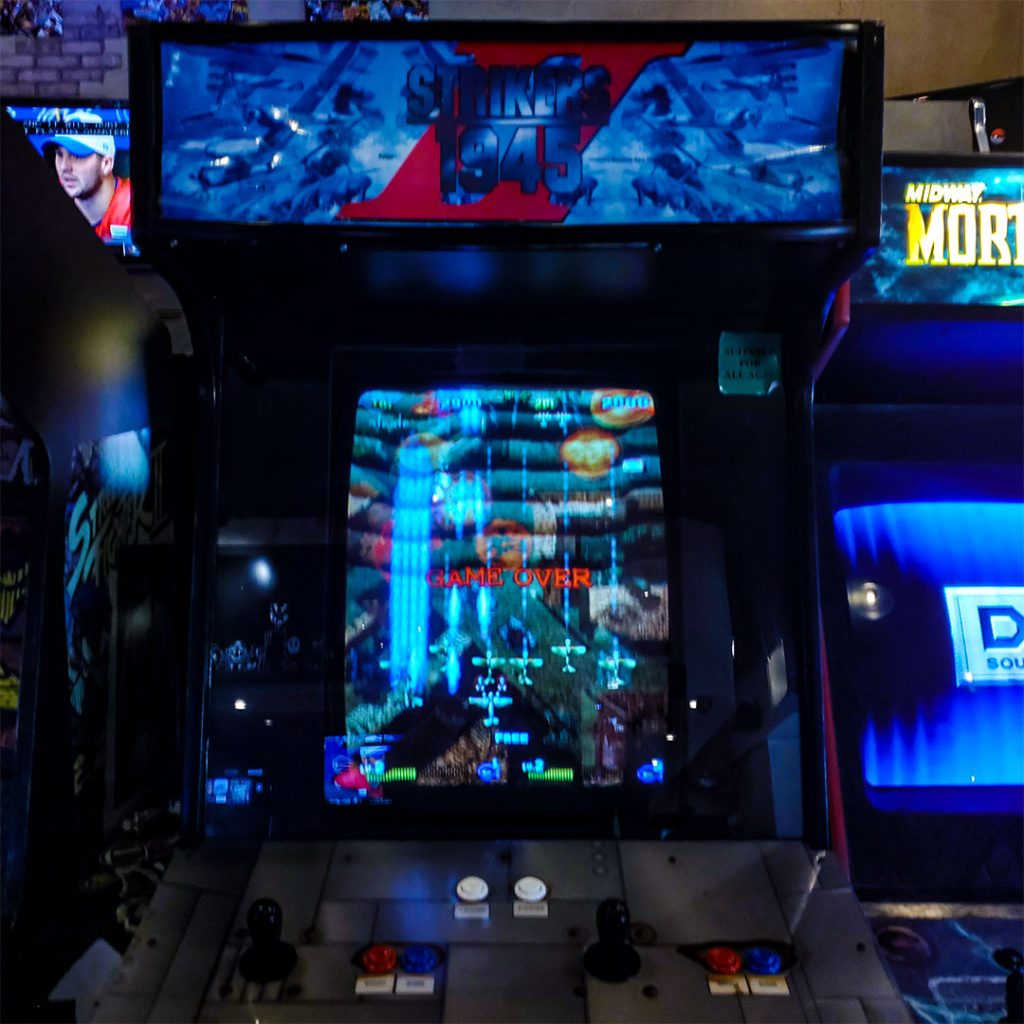
Released: 1989
Publisher: Konami
Developer: Konami
Teenage Mutant Ninja Turtles, released in Japan as TMNT: Super Kame Ninja and in Europe as Teenage Mutant Hero Turtles, is a 1989 beat ’em up arcade game released by Konami. It is based on the Teenage Mutant Ninja Turtles franchise, including the first animated series that began airing two years earlier. In the game, up to four players control the titular Ninja Turtles, fighting through various levels to defeat the turtles’ enemies, including the Shredder, Krang and the Foot Clan. Released during a high point in popularity for the Teenage Mutant Ninja Turtles franchise, the arcade game was a worldwide hit, becoming the highest-grossing dedicated arcade game of 1990 in the United States and Konami’s highest-grossing arcade game. Versions for various home systems soon followed, including the Nintendo Entertainment System. A sequel, Teenage Mutant Ninja Turtles: Turtles in Time, was released in 1991.
The player chooses from one of the four Ninja Turtles: Leonardo, Michelangelo, Donatello, and Raphael. Depending on the version of the game, the characters are either chosen via an in-game select screen or based on which coin slot the player placed their credit into. After Shredder kidnaps the Turtles’ friend April O’Neil and their mentor Splinter, they must give chase, save their comrades, and defeat the evil Shredder. Up to four players (two in some versions) can take control of any of the Turtles. Donatello has slower attacks but a longer range, Michelangelo and Raphael have faster attacks but a shorter range, and Leonardo is a well-rounded Turtle with average range and speed.
The eight-way joystick controls the movements of the Turtle, the jump button makes them jump and the attack button makes them hit in front of them using their weapon. The Turtles can also perform special moves, including throwing Foot soldiers overhead and performing a special attack by pressing the jump and attack buttons; Raphael rolls along the ground and finishes with a kick, while the other Turtles do a sweeping jump attack with their weapons. The Turtles can also spring off the wall in certain areas. Enemies can be defeated more quickly by slamming them into walls or solid objects. Many objects such as traffic cones, parking meters, fire hydrants and exploding oil drums can be hit or damaged with attacks in order to help defeat nearby enemies. In the attract mode, the game shows the first part of the cartoon opening, along with a portion of the Teenage Mutant Ninja Turtles theme song.
Most of the enemies the Turtles face are the Foot Soldiers, all color-coded to indicate their attack patterns and weapon of choices. Some enemies, such as the standard purple-clad Foot Soldiers and Roadkill Rodney robots, have the ability to restrain the Turtles’ mobility and drain their health, leaving only the player open to attack for other enemies. The bosses in the game include Rocksteady and Bebop (individually at first in that order, and later the two of them together), Baxter Stockman (in his human form), Granitor, General Traag, Krang, and Shredder himself.
You can read more about the TMNT arcade game here.
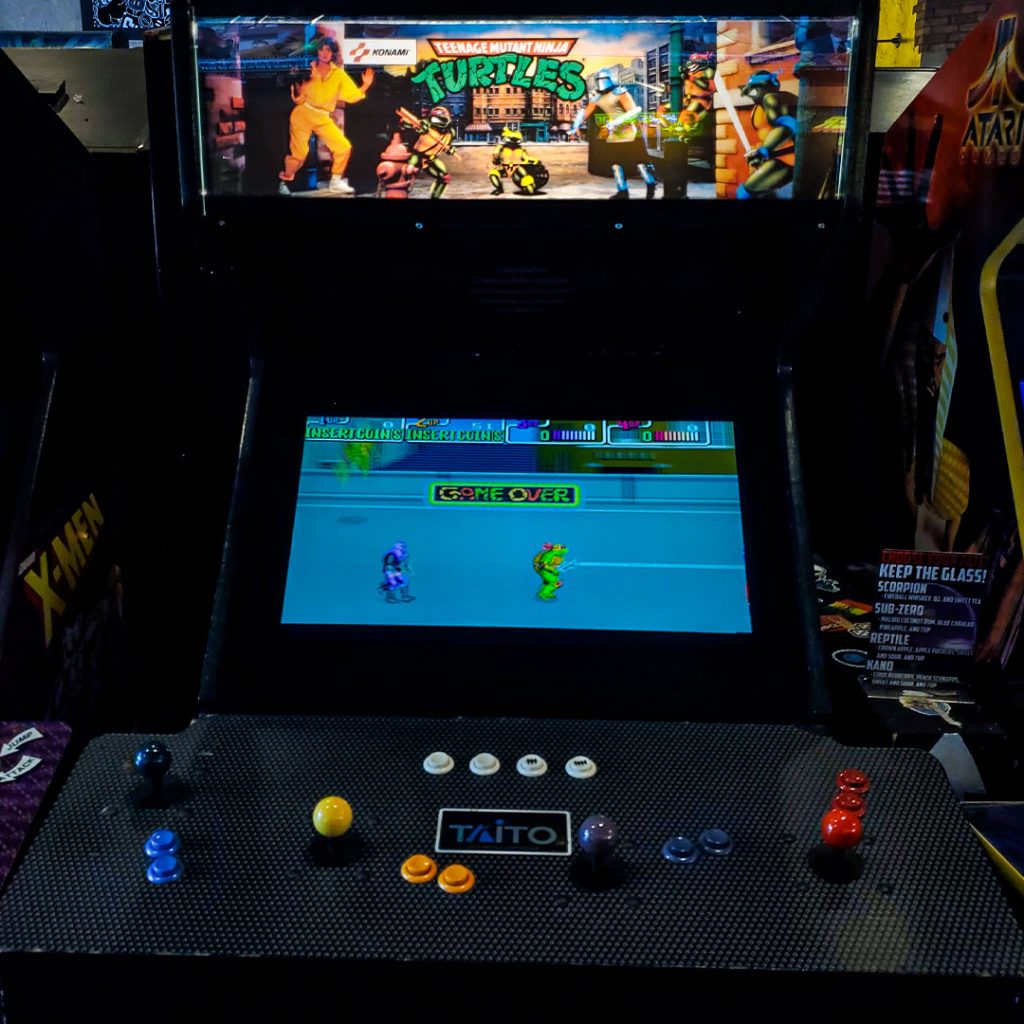
Released: 1984
Publisher: Various
Developer: Alexey Pajitnov
Tetris (Russian: Тетрис) is a puzzle video game created by Soviet software engineer Alexey Pajitnov in 1984. It has been published by several companies for multiple platforms, most prominently during a dispute over the appropriation of the rights in the late 1980s. After a significant period of publication by Nintendo, the rights reverted to Pajitnov in 1996, who co-founded the Tetris Company with Henk Rogers to manage licensing.
In Tetris, players complete lines by moving differently shaped pieces (tetrominoes), which descend onto the playing field. The completed lines disappear and grant the player points, and the player can proceed to fill the vacated spaces. The game ends when the uncleared lines reach the top of the playing field. The longer the player can delay this outcome, the higher their score will be. In multiplayer games, players must last longer than their opponents; in certain versions, players can inflict penalties on opponents by completing a significant number of lines. Some versions add variations on the rules, such as three-dimensional displays or a system for reserving pieces.
Built on simple rules, Tetris established itself as one of the great early video games. By December 2011, Tetris had sold 202 million copies – approximately 70 million physical units and 132 million paid mobile game downloads – making it one of the best-selling video game franchises of all time. The Game Boy version is one of the best-selling games of all time, with more than 35 million copies sold. Tetris is available on over 65 platforms, setting a Guinness world record for the most ported video game. Tetris is rooted within popular culture and its popularity extends beyond the sphere of video games; imagery from the game has influenced architecture, music and cosplay. The game has also been the subject of various research studies that have analyzed its theoretical complexity and have shown its effect on the human brain following a session, in particular the Tetris effect.
You can read more about Tetris here.
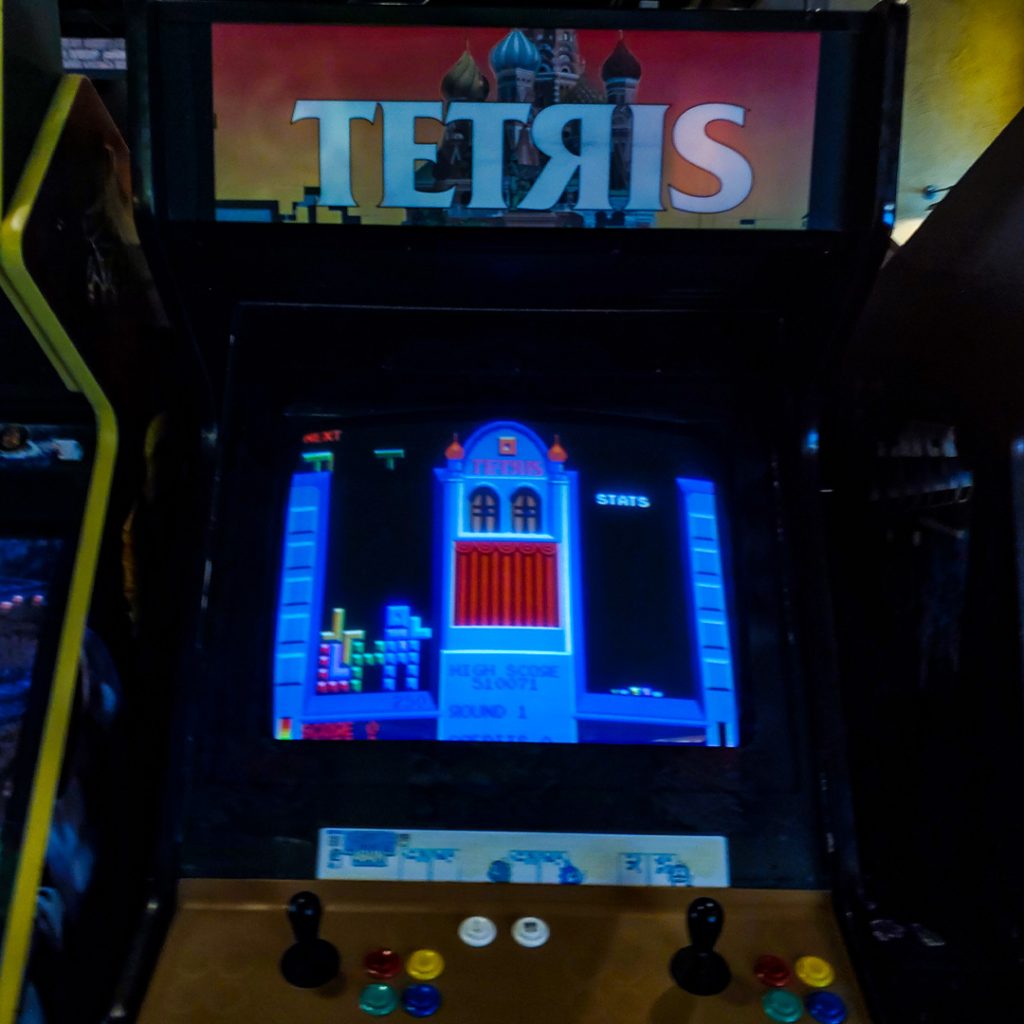
Released: 1981 – 1982
Publisher: Williams Electronics
Developer: Varies
The Williams Multigame features five classic titles all on one machine!
– Stargate: Stargate is a side-scrolling shooter game released for arcades in 1981 by Williams Electronics. Created by Eugene Jarvis and Larry DeMar, it is a sequel to Defender which was released earlier in the year. It was the first of only three productions from Vid Kidz, an independent development house formed by Jarvis and DeMar. Some of home ports of Stargate were renamed to Defender II for legal reasons. You can read more about Stargate here.
– Robotron: Robotron: 2084 (also referred to as Robotron) is a multidirectional shooter developed by Eugene Jarvis and Larry DeMar of Vid Kidz and released in arcades by Williams Electronics in 1982. The game is set in the year 2084 in a fictional world where robots have turned against humans in a cybernetic revolt. The aim is to defeat endless waves of robots, rescue surviving humans, and earn as many points as possible. You can read more about Robotron here.
– Defender: Defender is a scrolling shooter video game developed by Williams Electronics in 1980 and released for arcades in 1981. A side-scrolling shooter, the game is set on either an unnamed planet or city (depending on platform) where the player must defeat waves of invading aliens while protecting astronauts. You can read more about Defender here.
– Bubbles: Bubbles is a 2D action game developed by Williams Electronics and released arcades in 1982. The player uses a joystick to control a bubble in a kitchen sink. The object is to progress through levels by cleaning the sink while avoiding enemies. You can read more about Bubbles here.
– Joust: Joust is an action game developed by Williams Electronics and released in arcades in 1982. While not the first two-player cooperative video game, Joust‘s success and polished implementation popularized the concept. Player 1 rides an ostrich, player 2 a stork. Repeatedly pressing the flap button gains altitude, while a two-directional joystick controls direction. In a collision with enemy knights riding buzzards—or the other player—the higher rider dismounts the other. You can read more about Joust here.
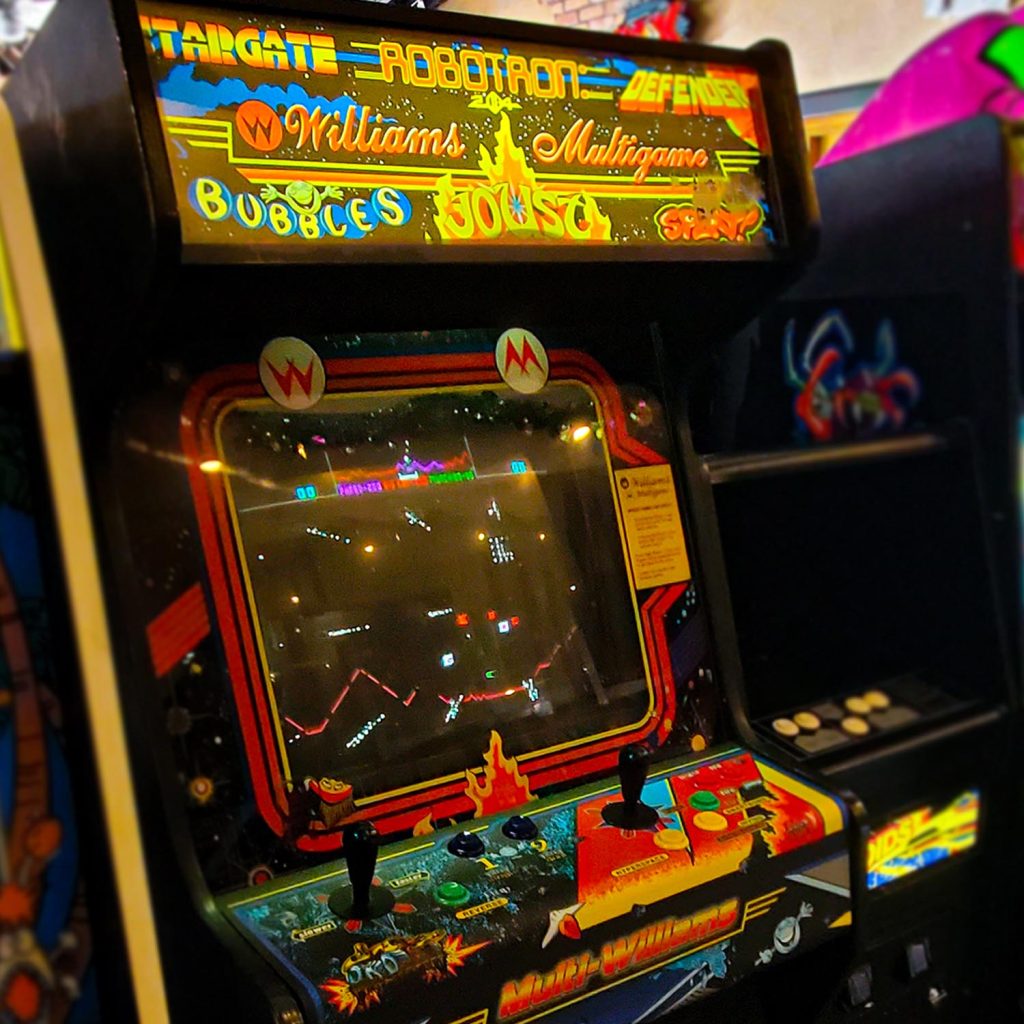
Released: 1991
Publisher: Technōs Japan
Developer: Yoshihisa Kishimoto, Shinichi Saito
WWF WrestleFest is a professional wrestling video game developed and released by Technōs Japan for arcades in 1991, featuring stars of the World Wrestling Federation (WWF). The game was distributed by Technōs in Japan and North America, and by Tecmo in Japan, Europe and Australasia. It is the sequel to Technōs’ previous WWF game, WWF Superstars. Compared to Superstars, WrestleFest adds a variety of different wrestlers to the roster as well as enhanced graphics and sound. There are more voice samples, including commentary and pre-match introductions by WWF ring announcer Mike McGuirk. The voiced cut scenes featuring Gene Okerlund from Superstars returned as well.
Just like its predecessor, WrestleFest simulates professional wrestling matches. The game adds support for up to four simultaneous players and the ability to insert more credits into the machine to buy energy. Two modes of play are available. In the new Royal Rumble mode, the player picks one superstar and takes him through a Royal Rumble match. In Saturday Night’s Main Event mode, the player must pick two wrestlers to form a tag team and take them through a series of matches, including a title match with the Legion of Doom. In this mode, players can perform numerous double team moves. Additionally, after a team member has been on the apron for a certain length of time, they will “power up,” temporarily giving them the ability to win all grapples and inflict more damage than usual.
The game features ten selectable wrestlers. Hulk Hogan, The Ultimate Warrior, “Million Dollar Man” Ted DiBiase and Big Boss Man return from WWF Superstars. Jake “The Snake” Roberts, Earthquake, Mr. Perfect, Sgt. Slaughter, Demolition Smash, and Demolition Crush, are available as new superstars, with The Legion of Doom (Hawk and Animal) making an appearance as a non-selectable boss tag team champions. Each wrestler has their own signature maneuvers.
You can read more about WWF Wrestlefest here.
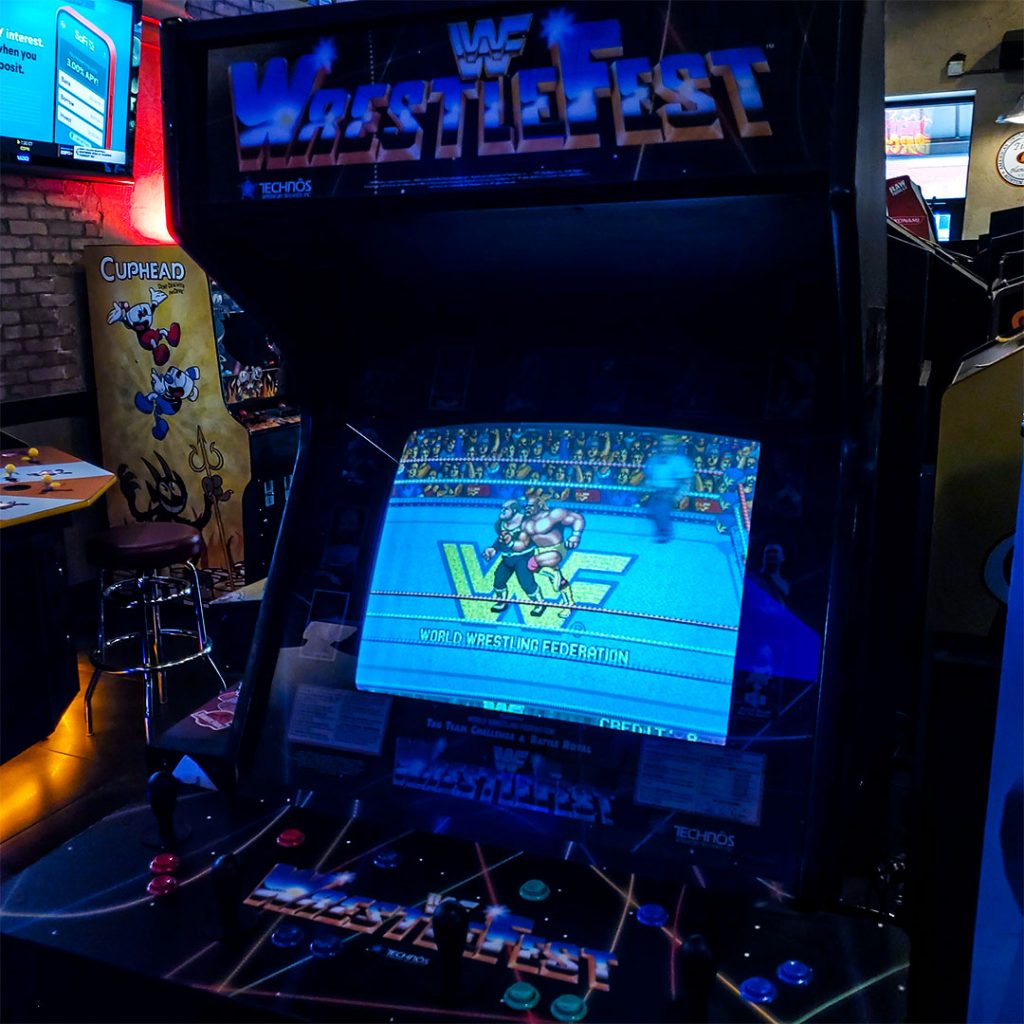
Released: 2020
Manufacturer: Flextronics, Foxconn
Developer: Microsoft
The Xbox Series X/S are home video game consoles developed by Microsoft. The higher-end Xbox Series X and lower-end Xbox Series S models were released on November 10, 2020, as the fourth-generation Xbox, succeeding the Xbox One. Along with Sony’s PlayStation 5, released the same month, the Xbox Series X/S consoles are part of the ninth generation of video game consoles.
Rumors about the consoles first emerged in early 2019, with the line as a whole codenamed “Scarlett” and consisting of high-end and lower-end models codenamed “Anaconda” and “Lockhart” respectively; “Anaconda” was teased by Microsoft during E3 2019 under the codename “Project Scarlett”, and unveiled during The Game Awards in December as Xbox Series X. On September 8, 2020, Microsoft unveiled the Xbox Series S.
As with the Xbox One line, the consoles use an AMD CPU and GPU. Both models have solid-state drives to reduce loading times, support for hardware-accelerated ray-tracing and spatial audio, the ability to convert games to high-dynamic-range rendering using machine learning (Auto HDR), support for HDMI 2.1 variable refresh rate and low-latency modes, and updated controllers. Xbox Series X was designed to nominally render games in 2160p (4K resolution) at 60 frames per second (FPS). The lower-end, digital-only Xbox Series S, which has reduced specifications and does not include an optical drive, was designed to nominally render games in 1440p at 120 FPS, with support for 4K video scaling and ray tracing.
Xbox Series X/S are backwards-compatible with nearly all Xbox One-compatible games and accessories (including Xbox 360 and original Xbox games that were made backward-compatible with Xbox One); the newer hardware gives games better performance and visuals. At launch, Microsoft encouraged a “soft” transition between generations, similar to PC gaming, offering the “Smart Delivery” framework to allow publishers to provide upgraded versions of Xbox One titles with optimizations for Xbox Series X/S. Publishers are not required to use Smart Delivery and may publish Xbox Series X/S-exclusive titles if they choose. Electronic Arts is among the developers that do not use Smart Delivery.
You can read more about the Xbox Series X & S here.
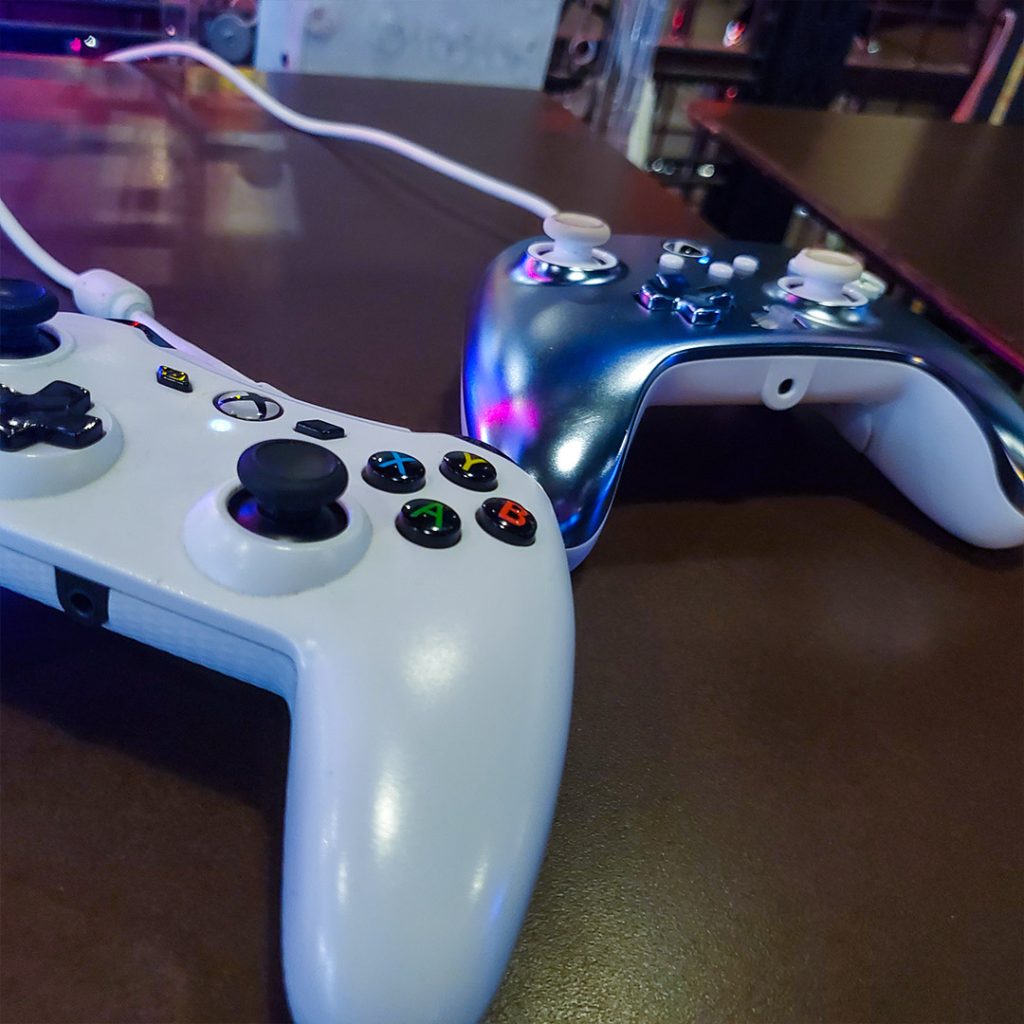
Released: 1992
Publisher: Konami
Developer: Konami
X-Men (エックス・メン) is a side-scrolling beat ’em up game produced and released by Konami for arcades in 1992, based on the Marvel Comics superhero team of the same name. The character designs of the characters in the game are based on the 1989 cartoon X-Men: Pryde of the X-Men. In the game, up to six players control the X-Men to defeat their archenemy Magneto. The six-player version of the game utilizes two screens housed in a deluxe cabinet. It was one of the top five highest-grossing dedicated arcade games of 1992 in the United States, while the Amusement & Music Operators Association (AMOA) nominated it for the “most innovative new technology” award.
An arcade exclusive for many years, a home version of the game developed by Backbone Entertainment was released by Konami digitally on the PlayStation 3 and Xbox 360 in 2010, followed by mobile versions for iOS and Android devices. This version is no longer available for purchase as of 2013.
The object of the game is to progress as far as possible while surviving attacks from Magneto and his minions. The character is controlled with a standard joystick, an attack button, a jump button, and a mutant power button. In addition to right and left, the character can move up and down the screen as well which adds a three-dimensional feel to the game. Every character is able to fight with punches, kicks, or other close combat attacks. Each character also has a unique mutant power which can be used to defeat multiple enemies on the screen at once. The use of a mutant power is very effective, but also costly since it causes a character to lose three health points. Normally, a character who drops below four health can no longer use any mutant powers, but it is also possible for characters to obtain bonus mutant powers which can be stored like items. In the Japanese version, the power items are used up before the health, and there are also power-ups and health packs throughout the levels.
You can read more about X-Men here.

Released: 1994
Publisher: Capcom
Developer: Capcom
X-Men: Children of the Atom (Japanese: エックス・メン チルドレン オブ ジ アトム, Hepburn: Ekkusu Men Chirudoren obu ji Atomu) is an arcade game that was produced by Capcom and released on the CP System II arcade hardware in 1994 in Japan and in 1995 in North America and Europe.
Based on the X-Men comic book, it is the first fighting game produced by Capcom using characters under license from Marvel Comics. Released around the time of the mid-1990s X-Men animated series, the game features voice actors from the series reprising their roles. The game’s plot is based on the “Fatal Attractions” story from the comics – players control one of the X-Men or their enemies in their fight against the villain Magneto. They face each of the other characters in the game in best of three one-on-one fighting matches, before battling Juggernaut and Magneto.
The gameplay has much in common with Capcom’s previous fighting games, Super Street Fighter II Turbo and Darkstalkers. Children of the Atom adds a combo system that features long combos that can even be performed in mid-air. Also featured in the game are various tactical maneuvers, including the ability for characters to roll. Children of the Atom introduced multi-tiered fighting environments in which the ground would crumble and characters would fall into lower parts of the level. These concepts and the fast pace of the game would provide the basis for Capcom’s Marvel vs. Capcom series, which started with the game’s successor X-Men vs. Street Fighter.
Ports of the game were released for Sega Saturn, PlayStation and personal computer. Of these, the PlayStation version was not as well received as the other versions, suffering from slowdown and missing frames of animation.
You can read more about X-Men: Children of the Atom here.
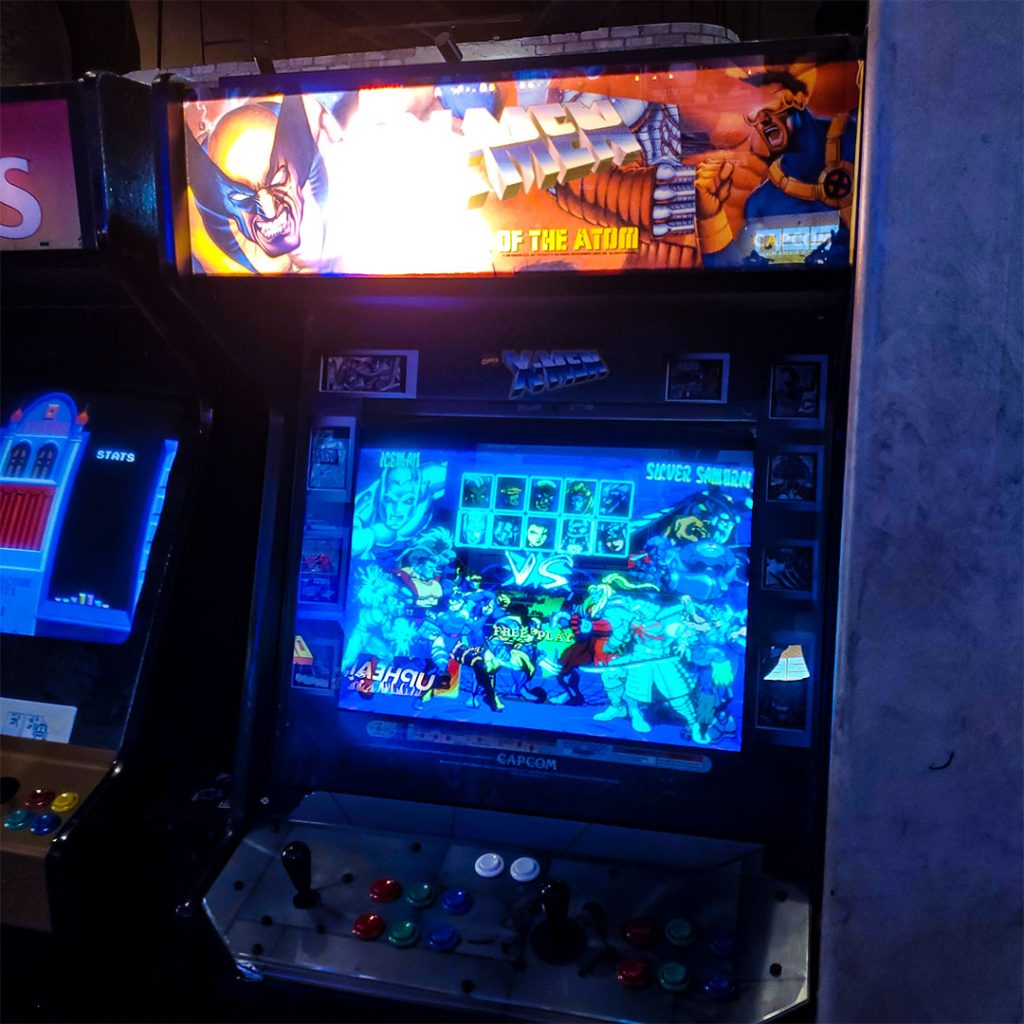
| THE BIG GAMER | $30/person |
| – Pizza – Wings with up to 4 Flavor Choices – Choice of 2 Appetizer Platters OR Dessert Platters – Fries – Unlimited Soft Drinks and Tea – Unlimited Arcade Games |
| WING PARTY | $25/person |
| – Wings with up to 4 Flavor Choice – Choice of 1 Appetizer Platter OR Dessert Platter – Fries – Unlimited Soft Drinks and Tea – Unlimited Arcade Games |
| PIZZA PARTY | $25/person |
| – Pizza – Choice of 1 Appetizer Platter OR Dessert Platter – Unlimited Soft Drinks and Tea – Unlimited Arcade Games |
| SNACK PARTY | $20/person |
| – Choice of up to 4 Appetizers – Unlimited Soft Drinks and Tea – Unlimited Arcade Games |
| APPETIZER CHOICES | |
| Cheese Sticks • Onion Rings • Cowboy Bites • Fried Ravioli • Fried Pickles • Fried Mushrooms • Queso • Chili Con Queso • Southwest Chicken Eggrolls |
| WING FLAVORS | |
| Buffalo Sauce • Dry Rub Buffalo • Garlic Parmesan • Lemon Pepper • Honey Barbeque • Dry Rub Cajun • Mango Habanero • Teriyaki ∙ Naked |
| HOUSE TICKETS | $4/ticket |
| All Bottled Beers • All Canned Beers • Small Draft Beers • Well Liquors • All House Wines by the glass |
| PREMIUM TICKETS | $7/ticket |
| All Bottled Beer • All Canned Beers • Tall Draft Beers • Well and Premium Liquors • All Menu Cocktails • House and Premium Wines by the glass • Fiji Water |